Historical monuments
GENERAL INFORMATION
There are 1162 historical-cultural monuments in Nakhchivan Autonomous Republic. 58 monuments are of the world importance, 455 monuments are of the country importance and 649 monuments are of the local importance.
The followings are included to the historical-cultural monuments.
The archaeological monuments -663
The architectural monuments -285
The monumental art monuments -31
The historical monuments -36
The places for pilgrimage -140
The nature monuments – 7
AGHOGHLAN TOMB
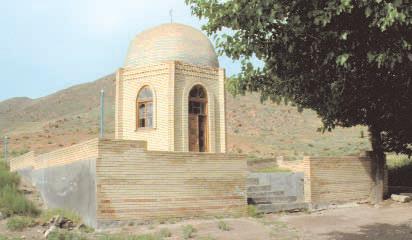 The sanctuary to the north of Sadarak village of Sadarak region. For the information of local people it was built on the grave of Seyid Pari. There is a legend about Seyid Pari and her son Aghoghlan. For the legend this very Aghoghlan provided a better living condition for the people by killing the ugly dervish. This territory is pilgrimaged by the people as a sacred place. The grave monument is of multifaced prism shape completed by the dome. The tomb entrance is from the south. There are spanned windows on the faces. The pilgrimas burn candles by resolving and place them onto the holes. The water of the spring around the tomb is said to be holy and curable as well.
The sanctuary to the north of Sadarak village of Sadarak region. For the information of local people it was built on the grave of Seyid Pari. There is a legend about Seyid Pari and her son Aghoghlan. For the legend this very Aghoghlan provided a better living condition for the people by killing the ugly dervish. This territory is pilgrimaged by the people as a sacred place. The grave monument is of multifaced prism shape completed by the dome. The tomb entrance is from the south. There are spanned windows on the faces. The pilgrimas burn candles by resolving and place them onto the holes. The water of the spring around the tomb is said to be holy and curable as well.
ALINJACHAY KHANAGAH (dwelling)
The architectural complex about the Middle Ages on Alinjachay bank, Khanagah village, Julfa region. From the complex, as known Sheykh Khorasan among people, only a tomb, a mosque and remainders of some buildings have reached up today. For the inscription installed on the top of the entrance door from south, the tomb was built by the architect Khaja Jamaladdin, by the order of Ulug Gutlug Lala bay, emir, isfahsalar, great scientist. Since the edge part of the inscription has gone to pieces to certaining the date of construction exactly was impossible. But for its architectural-constructive structure it may be related to the 12-13 centuries. There is one grave within the fortress. 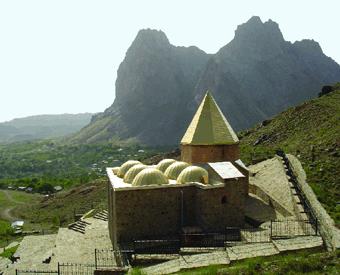 But since the inscription left to learn who had been buried in it was impossible. For the local people Fazlullah Naimi, the founder of hurifism, when killed tragically in 1394 in Alinja, his followers buried him here. Just for this, Khanagah complex named as (Sheykh Khorasan) by local people, is investigated by the specialists as one of nicknames of F.Naimi in the form of Sheykh Khurasa (having the meaning-Sunlike, Sheykh of blessed aspect) and as F. Naimi had come to Azerbaijan after his study in Khorasan, is explained as Sheykh from Khorasan. The tomb mosque close in the s. of the tomb was built by Khond Bika Khatun by hijri 901 (christianity 1495-96) to the memory of Sheykh Haji Lala Malik, one of the leaders of the mystic sector acting in the settlement that time. According to the tradition that time the Mystic Sheykhs lived in the settlement with their families and after death were buried near the settlement. So that, Sheykh Haji-Lala Malik lived there and ruled the settlement and after his death was buried at his own settlement and then Khond Bika Khatun (perhaps a wife of Sheykh) built a tomb mosque on the grave. Khond Bika khatun herself also after her death was buried around the settlement. The grave stone typed memorial monument at present remains at Khanagah. During restoration works around Khanagah the grave inscriptions about 1444-45, 1491-92, 1493 were discovered from under the ground, Khanagah was a settlement for the dervish who for a long time were busy with praying, resolving there. For the epigraphic evidences the settlement also existed in the 18 century and the members of this sector spread their ideas.
But since the inscription left to learn who had been buried in it was impossible. For the local people Fazlullah Naimi, the founder of hurifism, when killed tragically in 1394 in Alinja, his followers buried him here. Just for this, Khanagah complex named as (Sheykh Khorasan) by local people, is investigated by the specialists as one of nicknames of F.Naimi in the form of Sheykh Khurasa (having the meaning-Sunlike, Sheykh of blessed aspect) and as F. Naimi had come to Azerbaijan after his study in Khorasan, is explained as Sheykh from Khorasan. The tomb mosque close in the s. of the tomb was built by Khond Bika Khatun by hijri 901 (christianity 1495-96) to the memory of Sheykh Haji Lala Malik, one of the leaders of the mystic sector acting in the settlement that time. According to the tradition that time the Mystic Sheykhs lived in the settlement with their families and after death were buried near the settlement. So that, Sheykh Haji-Lala Malik lived there and ruled the settlement and after his death was buried at his own settlement and then Khond Bika Khatun (perhaps a wife of Sheykh) built a tomb mosque on the grave. Khond Bika khatun herself also after her death was buried around the settlement. The grave stone typed memorial monument at present remains at Khanagah. During restoration works around Khanagah the grave inscriptions about 1444-45, 1491-92, 1493 were discovered from under the ground, Khanagah was a settlement for the dervish who for a long time were busy with praying, resolving there. For the epigraphic evidences the settlement also existed in the 18 century and the members of this sector spread their ideas.
ASHABI-KAHF
A sanctuary in the natural cave, between Ilandagh and Nahajir mountains, at 12 km distance from Nakhchivan city. It means "Cave masters" in arabic. According to the 9-27 sentences (ayas) of the chapter "al-Kahf" in 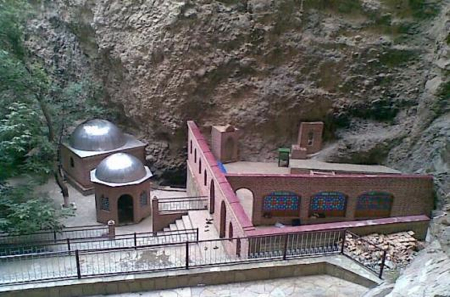 Korani-Kerim it is about those persons who had stood against those who trusted in others, besides God and as a result of which they had left them and hid themselves in that cave. They were 7 youth (Tamlikha, Barnush, Sarnush, Maksilma, Maslina, Sazanush, Kaftantush (shepherd) and their devoted dog Gitmir). It is about their sleeping over 300 years and the events they face with thereafter. The event existing in Korani-Kerim is related to the Ashabi-Kahf in Nakhchivan and underwent some changes. For a long time because of events falsification in some literatures the cave named in Korani-Kerim was connected with christianity with the territory of little Asia or Palestine and even in different world countries. The Ashabi - Kahf in Nakhchivan and the legend about it wasn't touched on those literature. But late years investigations have scientifically proved that the Ashabi-Kahf named in Korani-Kerim is situated in the territory of Nakhchivan and has no any relation with christianity. There is an inscription in the alter of the mosque situated at the end of the cave. The sentences 9-12, 17-18 from the "al-Kahf" chapter were engraved in the big size marble plate (145 x 35cm) center dealing with the events of Ashabi-Kahf of Korani-Kerim. The context of the inscription written on the sides of the plate,
Korani-Kerim it is about those persons who had stood against those who trusted in others, besides God and as a result of which they had left them and hid themselves in that cave. They were 7 youth (Tamlikha, Barnush, Sarnush, Maksilma, Maslina, Sazanush, Kaftantush (shepherd) and their devoted dog Gitmir). It is about their sleeping over 300 years and the events they face with thereafter. The event existing in Korani-Kerim is related to the Ashabi-Kahf in Nakhchivan and underwent some changes. For a long time because of events falsification in some literatures the cave named in Korani-Kerim was connected with christianity with the territory of little Asia or Palestine and even in different world countries. The Ashabi - Kahf in Nakhchivan and the legend about it wasn't touched on those literature. But late years investigations have scientifically proved that the Ashabi-Kahf named in Korani-Kerim is situated in the territory of Nakhchivan and has no any relation with christianity. There is an inscription in the alter of the mosque situated at the end of the cave. The sentences 9-12, 17-18 from the "al-Kahf" chapter were engraved in the big size marble plate (145 x 35cm) center dealing with the events of Ashabi-Kahf of Korani-Kerim. The context of the inscription written on the sides of the plate, 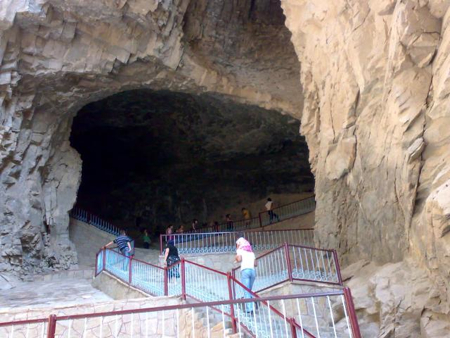 starting from right top to left top in a narrow shape, ribbonlike is so: "The writings were destroyed because of rain and snow damage. Considering this fact Shukurulla Khan Kangarli, the ruler of Nakhchivan State, the follower of Heydargulu Khan, the former ruler of the same state, a very charity person decided starting that to engrave another stone plate and to install in the place of the first as a memory thinking of the fate of this place. Pursuant to this decree Mahammad Khatib Nakhchivani, son of Mulla Mustafa, a religion man, started to prepare the memorial plate and in 1190 in the month of safar al-muzaffar (22.03.-20. 04-1776) completed the writing. As you see, before there was another inscription with the sentences from Korani Kerim but from time to time it had undergone weathering and then by the decree of Shukurulla khan Kangarli, the ruler of Nakhchivan state in that period the text had been engraved in another plate and put instead. By the task and care of Heydar Aliyev, national leader of Azerbaijan there were held construction-restoration works in Ashabi-Kahf. An inscription dealing with this fact was installed at the entrance of the place of pilgrimage. The inscription says: "The restoration and construction works in "Ashabi-Kahf" was carried in 1998 by the task and care of Heydar Aliyev, president of the Azerbaijan Republic. During restoration and construction works very normal conditions for pilgrimas were establised in Ashabi-Kahf, a very comfortable way of 13 km distance was built and planting works were held along the way, a mosque was built. At present pilgrims, tourists and guests from other regions of Azerbaijan and from foreign countries visit here regulary.
starting from right top to left top in a narrow shape, ribbonlike is so: "The writings were destroyed because of rain and snow damage. Considering this fact Shukurulla Khan Kangarli, the ruler of Nakhchivan State, the follower of Heydargulu Khan, the former ruler of the same state, a very charity person decided starting that to engrave another stone plate and to install in the place of the first as a memory thinking of the fate of this place. Pursuant to this decree Mahammad Khatib Nakhchivani, son of Mulla Mustafa, a religion man, started to prepare the memorial plate and in 1190 in the month of safar al-muzaffar (22.03.-20. 04-1776) completed the writing. As you see, before there was another inscription with the sentences from Korani Kerim but from time to time it had undergone weathering and then by the decree of Shukurulla khan Kangarli, the ruler of Nakhchivan state in that period the text had been engraved in another plate and put instead. By the task and care of Heydar Aliyev, national leader of Azerbaijan there were held construction-restoration works in Ashabi-Kahf. An inscription dealing with this fact was installed at the entrance of the place of pilgrimage. The inscription says: "The restoration and construction works in "Ashabi-Kahf" was carried in 1998 by the task and care of Heydar Aliyev, president of the Azerbaijan Republic. During restoration and construction works very normal conditions for pilgrimas were establised in Ashabi-Kahf, a very comfortable way of 13 km distance was built and planting works were held along the way, a mosque was built. At present pilgrims, tourists and guests from other regions of Azerbaijan and from foreign countries visit here regulary.
AZA BRIDGE
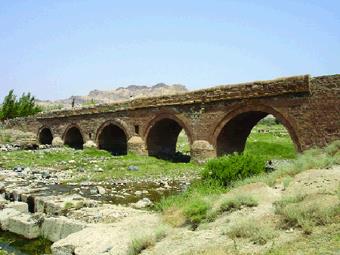 The architectural monument over the river Gilanchay in Aza village, Ordubad region. The bridge connecting Aza and Darkandi villages is 3,5 m in width, 46 pagonometers in length. Five spanned. Constructed with the redish colour ashlar local mountainous stone. When constructing the bridge the area was considered. Interspans distance was fixed differently. Four of the spans are having wave cutters. In order to smooth the activity of the trade caravans moving from east to west through along the Silk Road. The Aza bridge was constructed over the period of shah Ismayil (1587-1629), the Safavid leader in a place which had a great trade-caravan way importance connecting India and China with the Black sea countries and through where European countries indeed. By the trade caravans passing from here local products of which dry fruit, handicraft products, silk were exported. As a result of natural calamities and some historic events several times the bridge was destroyed and then was restored. Since the strong flood waters had destroyed a part of the bridge in 1977 it was restored capitally and reconstructed. At present people and transports from Nakhchivan and Ordubad going to Aza village use of this bridge. The bridge is about 17 century.
The architectural monument over the river Gilanchay in Aza village, Ordubad region. The bridge connecting Aza and Darkandi villages is 3,5 m in width, 46 pagonometers in length. Five spanned. Constructed with the redish colour ashlar local mountainous stone. When constructing the bridge the area was considered. Interspans distance was fixed differently. Four of the spans are having wave cutters. In order to smooth the activity of the trade caravans moving from east to west through along the Silk Road. The Aza bridge was constructed over the period of shah Ismayil (1587-1629), the Safavid leader in a place which had a great trade-caravan way importance connecting India and China with the Black sea countries and through where European countries indeed. By the trade caravans passing from here local products of which dry fruit, handicraft products, silk were exported. As a result of natural calamities and some historic events several times the bridge was destroyed and then was restored. Since the strong flood waters had destroyed a part of the bridge in 1977 it was restored capitally and reconstructed. At present people and transports from Nakhchivan and Ordubad going to Aza village use of this bridge. The bridge is about 17 century.
DARKAND DOME
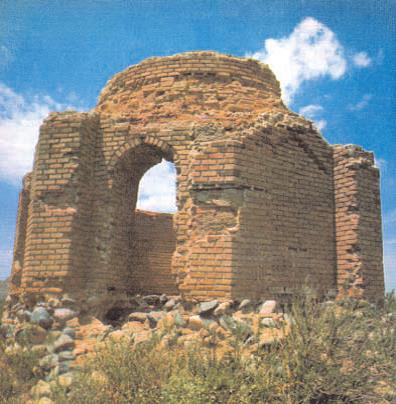 The architectural monument in Darkand, Ordubad region. The dome is differed for its composition and decorative elements. Darkand dome has been built of burnt bricks, the middle part of it consists of towershaped tombs and in the upper part is completed with a dome. Though the portal of the either side are characteristic for tower shaped tombs, they have a structure in the center of which leans against the foundation look like de fence walls. The simple designs in dark violet colour glazed bricks and simple designs built of simple burnt bricks on the tomb are the only decorative elements. Since the tomb hasn't got an inscription on it, to certain its history exactly is impossible. But composition structure, the colour of glazed materials on it, give an opportunity to think one version that it was built very late years compared with Garabaghlar and Barda tombs. Basing on this version we can say that Darkand dome was built at the end years of the 14 century or at the beginning of the 15 century.
The architectural monument in Darkand, Ordubad region. The dome is differed for its composition and decorative elements. Darkand dome has been built of burnt bricks, the middle part of it consists of towershaped tombs and in the upper part is completed with a dome. Though the portal of the either side are characteristic for tower shaped tombs, they have a structure in the center of which leans against the foundation look like de fence walls. The simple designs in dark violet colour glazed bricks and simple designs built of simple burnt bricks on the tomb are the only decorative elements. Since the tomb hasn't got an inscription on it, to certain its history exactly is impossible. But composition structure, the colour of glazed materials on it, give an opportunity to think one version that it was built very late years compared with Garabaghlar and Barda tombs. Basing on this version we can say that Darkand dome was built at the end years of the 14 century or at the beginning of the 15 century.
DIRNIS MOSQUE
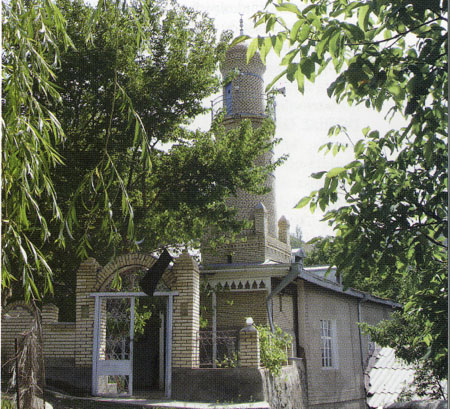 The historical monument in Mirza str. in Yukhari of Dirnis village, Ordubad region since it is very large for its size people call it Boyuk masjid (Big mosque). Jame mosque. Entrance from the west. Entrance for women from the east. The ceiling stands on 5x2=10 poles (columns). In front of the East North wall a balcony on the first floor has been installed for women. There are 3 big windows in the east wall, in the west wall 2, in the south wall 3. According to the inscription on one of the columns head written in black colour, it is cleared up that the mosque was repaired in 1339 by hijri calendar (1920-21) and it was Hasan from Ordubad who repaired the mosque. The mosque was repaired in 1999 on the expense of the people and a balcony had been assembled in front of the western entrance door and a minaret was erected. According to its architectural-constructive structure it is related to 17 century.
The historical monument in Mirza str. in Yukhari of Dirnis village, Ordubad region since it is very large for its size people call it Boyuk masjid (Big mosque). Jame mosque. Entrance from the west. Entrance for women from the east. The ceiling stands on 5x2=10 poles (columns). In front of the East North wall a balcony on the first floor has been installed for women. There are 3 big windows in the east wall, in the west wall 2, in the south wall 3. According to the inscription on one of the columns head written in black colour, it is cleared up that the mosque was repaired in 1339 by hijri calendar (1920-21) and it was Hasan from Ordubad who repaired the mosque. The mosque was repaired in 1999 on the expense of the people and a balcony had been assembled in front of the western entrance door and a minaret was erected. According to its architectural-constructive structure it is related to 17 century.
FARHAD HOUSE
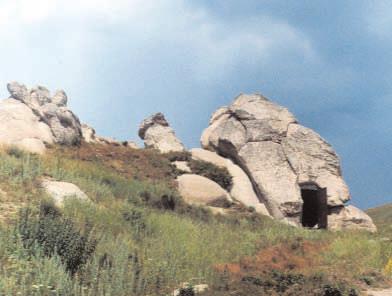 The archaeological monument in Batabat summer pasture, to the east from Bichanak village, Shahbuz region. To the right of Nakhchivan-Lachin-Yevlakh automobile way, at about 1 km distance to the east from Zorbulag. It consists of four rooms hewed by a hack typed metal tool in liparit tuffa rock. They are connected with a straight passage of the same direction. Ceilings are span shaped, floors oval planned. Little recesses were excavated on the walls for to install lamps or candles. Along the walls a pavement was constructed; there is a well, fire place in the right corner of the first room. The height of the entrance door is 2,2 m, width 1,3 m. A long haired man head in the right of the entrance and in the left a woman picture were engraved on the rock of Farhad house. A pavement 2 m in height, 5 m in length, 80 cm in width, 30 cm in depth from the caravan way in the north east slope of the rock was dug; a very old 3 lined writing (very hopeful cuneiform) was engraved (context unreadable condition) along the pavement. The vishap from the barrow shaped monument was stolen. The distance from Nakhchivan city to Farhad house is one part caravan way. Nakhchivan-Lachin-Yevlakh was regarded a way of great importance connecting the near east with the Southern Caucasus. There was built a stopping-station in Batabat summer pasture as known a Farhad house. Considering the rise of visitors through Nakhchivan-Batabat way a large caravansary was built a bit to the north from Farhad house in the Middle Ages. Local people called it Shah Abbas caravansaray. The investigations give an opportunity for us to say that Farhad house is about the end of the 1 millennium B.C. and early years of our century. Among people there are different legends concerning Fargad house.
The archaeological monument in Batabat summer pasture, to the east from Bichanak village, Shahbuz region. To the right of Nakhchivan-Lachin-Yevlakh automobile way, at about 1 km distance to the east from Zorbulag. It consists of four rooms hewed by a hack typed metal tool in liparit tuffa rock. They are connected with a straight passage of the same direction. Ceilings are span shaped, floors oval planned. Little recesses were excavated on the walls for to install lamps or candles. Along the walls a pavement was constructed; there is a well, fire place in the right corner of the first room. The height of the entrance door is 2,2 m, width 1,3 m. A long haired man head in the right of the entrance and in the left a woman picture were engraved on the rock of Farhad house. A pavement 2 m in height, 5 m in length, 80 cm in width, 30 cm in depth from the caravan way in the north east slope of the rock was dug; a very old 3 lined writing (very hopeful cuneiform) was engraved (context unreadable condition) along the pavement. The vishap from the barrow shaped monument was stolen. The distance from Nakhchivan city to Farhad house is one part caravan way. Nakhchivan-Lachin-Yevlakh was regarded a way of great importance connecting the near east with the Southern Caucasus. There was built a stopping-station in Batabat summer pasture as known a Farhad house. Considering the rise of visitors through Nakhchivan-Batabat way a large caravansary was built a bit to the north from Farhad house in the Middle Ages. Local people called it Shah Abbas caravansaray. The investigations give an opportunity for us to say that Farhad house is about the end of the 1 millennium B.C. and early years of our century. Among people there are different legends concerning Fargad house.
GAMIGAYA
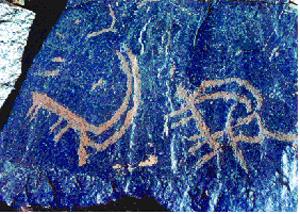 The mountain to the north east between Tivi and Nasirvaz villages, territory of Ordubad region. A top of the Zangazur chains watershed. Height is 3725 m. It appeared as a result of old volcanic soils, precipitous sloped, a cone shaped mountain. Gamigaya playing a very important economic role for centuries in the life of Nakhchivan people, the summer pastures of which became holy later on, and even natural temples appeared here. Name of it is connected with Noah. The mountain with sheer cliffs, the top of which is always covered with snow and white clouds from far away looks like a ship sailing in the highest top of the Lesser Caucasus (3904 m) was named Gamigaya. by people. Gamigaya being considered the holy pantheon of the old world attracts one's attention for its grandiose, fantastic view. There are petrogriphs-pictograms (old writings) about 4-1 millennium B.C.
The mountain to the north east between Tivi and Nasirvaz villages, territory of Ordubad region. A top of the Zangazur chains watershed. Height is 3725 m. It appeared as a result of old volcanic soils, precipitous sloped, a cone shaped mountain. Gamigaya playing a very important economic role for centuries in the life of Nakhchivan people, the summer pastures of which became holy later on, and even natural temples appeared here. Name of it is connected with Noah. The mountain with sheer cliffs, the top of which is always covered with snow and white clouds from far away looks like a ship sailing in the highest top of the Lesser Caucasus (3904 m) was named Gamigaya. by people. Gamigaya being considered the holy pantheon of the old world attracts one's attention for its grandiose, fantastic view. There are petrogriphs-pictograms (old writings) about 4-1 millennium B.C.
GARABAGHLAR TOMB
The historical-architectural monument about the Middle Ages in Garabaghlar village, Kangarli region excluding the tomb included to the architectural complex there are the remnants of twin minarets and a religious building among them. The twin minarets are supposed to have been built at the end of the 12, beginning of the 13 centuries. The head-span joining the minarets is about 14 century. Since the name of Guti khatun, wife of Hulaku khan, elkhanid ruler was written on the headspan it is supposed the tomb had been built in honour of 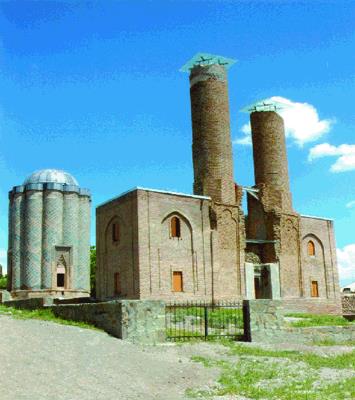 Guti khatun. In 1928 M.Mirheydarzadeh, scientific secretary of Nakhchivan "Investigation and Thoroughly Research Society" defined the following words in the inscription of the twin minarets headspan written in Arabic: "This sign of God is turkman Guti khatun". In Garabaghlar tomb consisting of the vault and overground part and resembled the main features of towershaped tombs. 12 halfcylindric projections joining in a form of cluster on a stone rostrum complete the overground composition of Garabaghlar tomb. The projections give a magnificent fortress image to the tomb by lessening the total size of the wall. The walls of 12 angled underground vault of the tomb were built of stones with domes of bricks. The surface of Garabaghlar tomb was covered with red and turquoise glazed brick, designed with inscriptions remembering geometric ornaments. The context of the inscriptions consists of turquoise glazed bricks arranged horizontally, unglazed red bricks placed vertically and prepared by means of bricks and repeatedly written in the rhombics "la-ilaha illallah Mahammadan Rasulallah" (There is no God but God and Mohammad is his Rasul (envoy)!). But this one in a way reminds the inscription with ornaments of Barda tomb about 1322. The inscription sash on the upper part was written in naskh lettering. The inscription of blue glaze basement was written in white letters. The composition feature of Garabaghlar tomb is its being of 4 headspans give 4 faced image to the tomb being arranged in south-west and north directions. Headspans surface was covered with glazed tile and decorated with geometric and nature designs. Among them the most interesting is the main headspan in the n direction. As the upper conicshaped dome and certain inscriptions had been destroyed to determine the exact date of Garabaghlar tomb was impossible. But despite of this all investigations arrive at a conclusion that the tomb was built at the beginning of 14 century. For the similarity of Garabaghlar tomb with Barda tomb and the date of both to have been built at the beginning of 14 century, gives an opportunity to say that both monuments belong to the same architectural schooling and even to say that it was constructed by Ahmad Ayyub oglu Hafiz Nakhchivani, great figure of Nakhchivan architectural schooling, the architect of the Barda tomb.
Guti khatun. In 1928 M.Mirheydarzadeh, scientific secretary of Nakhchivan "Investigation and Thoroughly Research Society" defined the following words in the inscription of the twin minarets headspan written in Arabic: "This sign of God is turkman Guti khatun". In Garabaghlar tomb consisting of the vault and overground part and resembled the main features of towershaped tombs. 12 halfcylindric projections joining in a form of cluster on a stone rostrum complete the overground composition of Garabaghlar tomb. The projections give a magnificent fortress image to the tomb by lessening the total size of the wall. The walls of 12 angled underground vault of the tomb were built of stones with domes of bricks. The surface of Garabaghlar tomb was covered with red and turquoise glazed brick, designed with inscriptions remembering geometric ornaments. The context of the inscriptions consists of turquoise glazed bricks arranged horizontally, unglazed red bricks placed vertically and prepared by means of bricks and repeatedly written in the rhombics "la-ilaha illallah Mahammadan Rasulallah" (There is no God but God and Mohammad is his Rasul (envoy)!). But this one in a way reminds the inscription with ornaments of Barda tomb about 1322. The inscription sash on the upper part was written in naskh lettering. The inscription of blue glaze basement was written in white letters. The composition feature of Garabaghlar tomb is its being of 4 headspans give 4 faced image to the tomb being arranged in south-west and north directions. Headspans surface was covered with glazed tile and decorated with geometric and nature designs. Among them the most interesting is the main headspan in the n direction. As the upper conicshaped dome and certain inscriptions had been destroyed to determine the exact date of Garabaghlar tomb was impossible. But despite of this all investigations arrive at a conclusion that the tomb was built at the beginning of 14 century. For the similarity of Garabaghlar tomb with Barda tomb and the date of both to have been built at the beginning of 14 century, gives an opportunity to say that both monuments belong to the same architectural schooling and even to say that it was constructed by Ahmad Ayyub oglu Hafiz Nakhchivani, great figure of Nakhchivan architectural schooling, the architect of the Barda tomb.
GAZANCHI BRIDGE
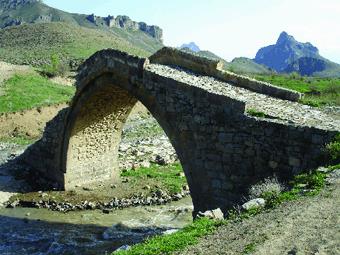 Historical architectural monument built over the Alinjachay, to the south of Gazanchi village, Julfa region. The bridge is popular as "Gozbel korpu" (Humped bridge) among people. The bridge was built in 16-17 centuries in the eastern architectural style. Before, by this bridge displaying its activity for Silk Road service, the caravan ways stretching from Gazanchi toward the east direction and joining with the key way in Ordubad territory passed. Though the bridge in comparison is good but for a transport is unfit. Despite of this it is said to be one of the best examples of a one spanned bridges of Azerbaijan. The width of the bridge is 3,55 m, length 10,85 m, height 8,8 m. The bridge was built of a bit of hewed stones. The border and archievalt of the spans consist of sandstone hewed perfectly. Thanks to this the sides of spans are differed from the unhewed surface of bridge and reflects its construction.
Historical architectural monument built over the Alinjachay, to the south of Gazanchi village, Julfa region. The bridge is popular as "Gozbel korpu" (Humped bridge) among people. The bridge was built in 16-17 centuries in the eastern architectural style. Before, by this bridge displaying its activity for Silk Road service, the caravan ways stretching from Gazanchi toward the east direction and joining with the key way in Ordubad territory passed. Though the bridge in comparison is good but for a transport is unfit. Despite of this it is said to be one of the best examples of a one spanned bridges of Azerbaijan. The width of the bridge is 3,55 m, length 10,85 m, height 8,8 m. The bridge was built of a bit of hewed stones. The border and archievalt of the spans consist of sandstone hewed perfectly. Thanks to this the sides of spans are differed from the unhewed surface of bridge and reflects its construction.
GEYSARIYYA
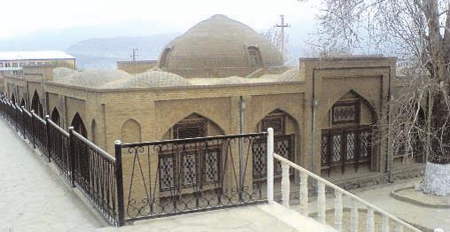 The historical monument about 17 century, Ordubad city. Situated in the center of the city. Total area 540 m2. The monument consists of a hall center which is a 10 x 10 octagonal wis a round dome covering its roof, very complicated four supporters holding the dome in the corners and the passages (width 3,4 m) arranging between the supporters and side wall recesses. The sizes of recesses in the walls of the supporter are 1,4 x 1,45 x 2,2 m. Despite of the support recesses the side wall recesses are of join span constructive, size 3,4 x 1,37 x 3 m. The passages roof has been covered with 16 little domes. The monument has been built of burnt bricks, the thickness of wall is 80 cm. The total height of the monument including its dome is 8,5 m. Including central dome its eastern bazaar in which some belongings of the shahs-jewels, red precious stones and so on were put on sale. This kind of construction exists in 3 places of the world: Samargand. Tabriz and Ordubad cities. At present the most magnificient and amenity of that is in Ordubad. Later on this monument had been used as "Zorkhana" (wrestling hall). As the hall floor was lower that the one of building they used to bring babius bushes from the mountains to cover the floor instead of a mattress and over of which covered that with fine soil. Wrestlers from Iran, Turkey, Hamadan and other places demonstrated their power in this arena. He who became winner was presented with a little pouch of gold by the khan sitting in the room and watching. Member of "Anju mani-Shuara" literary society that was established about in the mid. of 19 century (founder was a person by name Karbalayi Mulla Ahmad from Ordubad who knew Arabic and Persian well, writing lampoons and satires, but unfortunately his works didn't reach our time)-Hajiagha Fagir Ordubadi, Mahammad Taghi Sidgi, Gudsi Vanandi, Ashig Abbas Dahri, Usta Zeynal naggash, Haji Ahmad Bikas and others assembled in this building and read their poems and finally declared the name of the best. During tzar Russia period Geysariyya was bought by an uchturlangali medical assistant Gasim's grandfather and cobbler Ibrahim's grandfather with gold and had been turned into a silk weaving shop. In the Soviet time a part of them was used as a shop and a warehouse and another part as a canteen. At the end of the 20 century, in 1978 the monument was restored by Zakir Hashim oglu Babayev, architect from Ordubad. Since 1981 Geysariyya has been acting as History-ethnography Museum of Ordubad region.
The historical monument about 17 century, Ordubad city. Situated in the center of the city. Total area 540 m2. The monument consists of a hall center which is a 10 x 10 octagonal wis a round dome covering its roof, very complicated four supporters holding the dome in the corners and the passages (width 3,4 m) arranging between the supporters and side wall recesses. The sizes of recesses in the walls of the supporter are 1,4 x 1,45 x 2,2 m. Despite of the support recesses the side wall recesses are of join span constructive, size 3,4 x 1,37 x 3 m. The passages roof has been covered with 16 little domes. The monument has been built of burnt bricks, the thickness of wall is 80 cm. The total height of the monument including its dome is 8,5 m. Including central dome its eastern bazaar in which some belongings of the shahs-jewels, red precious stones and so on were put on sale. This kind of construction exists in 3 places of the world: Samargand. Tabriz and Ordubad cities. At present the most magnificient and amenity of that is in Ordubad. Later on this monument had been used as "Zorkhana" (wrestling hall). As the hall floor was lower that the one of building they used to bring babius bushes from the mountains to cover the floor instead of a mattress and over of which covered that with fine soil. Wrestlers from Iran, Turkey, Hamadan and other places demonstrated their power in this arena. He who became winner was presented with a little pouch of gold by the khan sitting in the room and watching. Member of "Anju mani-Shuara" literary society that was established about in the mid. of 19 century (founder was a person by name Karbalayi Mulla Ahmad from Ordubad who knew Arabic and Persian well, writing lampoons and satires, but unfortunately his works didn't reach our time)-Hajiagha Fagir Ordubadi, Mahammad Taghi Sidgi, Gudsi Vanandi, Ashig Abbas Dahri, Usta Zeynal naggash, Haji Ahmad Bikas and others assembled in this building and read their poems and finally declared the name of the best. During tzar Russia period Geysariyya was bought by an uchturlangali medical assistant Gasim's grandfather and cobbler Ibrahim's grandfather with gold and had been turned into a silk weaving shop. In the Soviet time a part of them was used as a shop and a warehouse and another part as a canteen. At the end of the 20 century, in 1978 the monument was restored by Zakir Hashim oglu Babayev, architect from Ordubad. Since 1981 Geysariyya has been acting as History-ethnography Museum of Ordubad region.GILAN TOMB
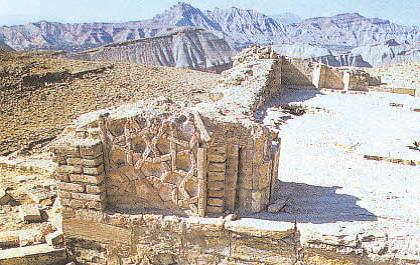 The architectural monument about the Middle Ages in Ordubad region. Discovered in 1979 in the place of Kharaba Gilan city. The monument conditionally named "Gilan tomb" is situated on the slope of a big hill. The upper tower destroyed, but the vault is in good order. Outer plan of the vault is right angled but inside plan is octagon shaped. There is a low pavement built newly and not making ensemble with its inside. The vault of Gilan tomb is differed from the octagon vaults widely spread in Azerbaijan and border countries of the Middle Ages architecture, for its deep recess opposing the entrance door and cover construction. The middle of the cover in Gilan vault touches on the mushroom shaped column inside center widenning toward upright. The column is octagon in plan, too. A central support column like this is only known from the vaults of two monuments in the territory of Azerbaijan - Red dome in Maragha (1148), and Momuna Khatun tomb (1186) in Nakhchivan .Though Gilan tomb is in the architectural climate of Maragha-Nakhchivan for its architectural system and construction it is the same with lower layer of Mengujug Gazi tomb (12 century) in Kemah settlement of the eastern Anadolu (Turkey). The capacity and height of both vaults are too close to each-other. There is a strong belief that the tomb in Kemah also has been built by a member of Maragha-Nakhchivan architectural schooling. Because during those years all kinds of constructions of Mengujugs were fulfilled by two Azerbaijan architects. Keykavus tomb erected in Sivash by Ahmad Abubakr oglu Marandi architect is alike of Gilan and Kemah tombs for its appearance. Gilan vault was built of flat stone pieces dug in the around rocks. Compared with its inside, outside stones were hewed more carefully and construction work was done neatily. Ceiling and floor in the interior and also masonry joins of the walls and central supporter were plastered with a white solution. Dark grey stones of their natural sizes and unevenness make original harmony with decorative laying on the white floor. Wholly the expressiveness of the vault interior bases on clear capacity structure of sizes, meets with aesthetic requirements and influences highly with the space of plastic architectonics. Before, there was a cubic shaped body on the roof of the vault. The upper tower completely built of bricks was destroyed, but now only little fragments of it remain. The faces of which were built of bricks and decorated with complicated designs. The body corners had been embraced by cylindrical brick columns. A lower part one of the columns remained. Green colour pot plates were used in decoration works. Though the inscription of Gilan tomb doesn't remain to certain of its date but it is expected the monument was built in the last quarter of 12 century.
The architectural monument about the Middle Ages in Ordubad region. Discovered in 1979 in the place of Kharaba Gilan city. The monument conditionally named "Gilan tomb" is situated on the slope of a big hill. The upper tower destroyed, but the vault is in good order. Outer plan of the vault is right angled but inside plan is octagon shaped. There is a low pavement built newly and not making ensemble with its inside. The vault of Gilan tomb is differed from the octagon vaults widely spread in Azerbaijan and border countries of the Middle Ages architecture, for its deep recess opposing the entrance door and cover construction. The middle of the cover in Gilan vault touches on the mushroom shaped column inside center widenning toward upright. The column is octagon in plan, too. A central support column like this is only known from the vaults of two monuments in the territory of Azerbaijan - Red dome in Maragha (1148), and Momuna Khatun tomb (1186) in Nakhchivan .Though Gilan tomb is in the architectural climate of Maragha-Nakhchivan for its architectural system and construction it is the same with lower layer of Mengujug Gazi tomb (12 century) in Kemah settlement of the eastern Anadolu (Turkey). The capacity and height of both vaults are too close to each-other. There is a strong belief that the tomb in Kemah also has been built by a member of Maragha-Nakhchivan architectural schooling. Because during those years all kinds of constructions of Mengujugs were fulfilled by two Azerbaijan architects. Keykavus tomb erected in Sivash by Ahmad Abubakr oglu Marandi architect is alike of Gilan and Kemah tombs for its appearance. Gilan vault was built of flat stone pieces dug in the around rocks. Compared with its inside, outside stones were hewed more carefully and construction work was done neatily. Ceiling and floor in the interior and also masonry joins of the walls and central supporter were plastered with a white solution. Dark grey stones of their natural sizes and unevenness make original harmony with decorative laying on the white floor. Wholly the expressiveness of the vault interior bases on clear capacity structure of sizes, meets with aesthetic requirements and influences highly with the space of plastic architectonics. Before, there was a cubic shaped body on the roof of the vault. The upper tower completely built of bricks was destroyed, but now only little fragments of it remain. The faces of which were built of bricks and decorated with complicated designs. The body corners had been embraced by cylindrical brick columns. A lower part one of the columns remained. Green colour pot plates were used in decoration works. Though the inscription of Gilan tomb doesn't remain to certain of its date but it is expected the monument was built in the last quarter of 12 century.
GULUSTAN TOMB
The architectural monument about the Middle Ages, near Gulustan village, Julfa region. Gulustan tomb built under the influence of Momuna khatun tomb at the beginning of 13 century is included to the tower shaped tombs group of Azerbaijan. The 12 faced body of the tomb was built of red sand stones, but its rostrum with original structure (corners cut cubic formed) was built of hewed stones. Despite of other tombs in Azerbaijan, the vault of Gulustan is situated on the overground. The rostrum consists of section pyramid outside but sylindric structure inside. The section pyramid square in plan (6.6 x 6.6 m) in outside upper part turns into proper twelve angels and twelve faced upper chamber is situated on it. Upper cover of the tomb was completely destroyed. Therefore to identify the cover's being pyramidal or cone shaped is very difficult. The tomb surfaces have been decorated with the engraved geometric ornaments and framed with the decorative spans. Each face of the tower is completed with the spans by means of hollow corners forking. As it yes in Ajami Nakhchivani's tombs, here also inside of the recesses was covered with neaty geometric designs. When observing the designs on the twelve faces we can easily be certain that there are only three systematically repeated geometric designs. The body part joining with bottom as well as the point of passage to the tower has been encircled with a belt of stalactite form. Joining the ornaments with other decorative elements systematically and connection give a hollow and elastic image to the monument. The space structure of Gulustan tomb is a bright example from circle to a square base, from cubic capacity to a cone base and so artistic technical solution of proportionate systems passing into one another. Since Anadolu is an area in which such tombs have spread widely we can consider Gulustan tomb as a key indicator for Azerbaijan and Anadolu Saljug tombs family unity. For the systematism between architecture forms, for the neatiness of size and designs the Gulustan tomb has got advantages compared with these stone tombs.
HAJI HUSEYNGULU MOSQUE
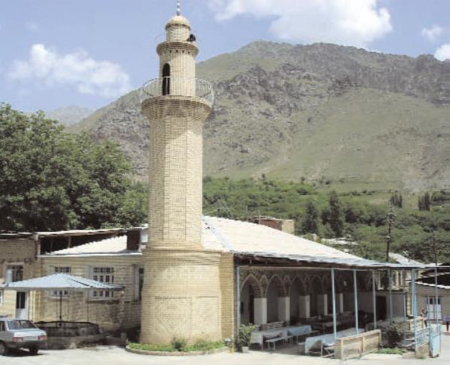 The historical architectural monument in Ganza village, Ordubad region, in the center of the village. Size is 23 x 14 m. Although it has no inscription on it but for local people it was built by Haji Huseyngulu, an influential man. When died he was buried in front of the south wall of the mosque. There is no any epigraphic documents or inscription on the grave as it yes on the mosque. But later when the mosque was restored, also there was put a head stone and a chest stone on the grave. The words "Late Haji Huseyngulu, 16 century" was written in Arabic on the head stone. Being one of the oldest mosque sample monuments in Nakhchivan province inside of it consists of a big hall. They say at the beginning of the 20 century one more hall was built and joined with the hall belonging to males in the west part of the former mosque. The main, old part of the mosque sits on three big columns and walls built of stones. Intercolumns and the part between the columns and walls was connected in span form. The thickness of the walls is 1 m. Five wall recesses have been installed inside of the mosque. A balcony is in front of the entrance. The facade of it consists of 12 spans. Near the mosque there is a guest house. When restoring on the limed walls there were written religion words in colour. During restoration a very wonderful minaret has been erected in the south-west direction. On the minaret an inscription says: "The minaret of the mosque was built by Haji Israfil Sadigli in 2000. Architects Karbalayi Sayid, Karbalayi Gurban". Mourning parties and religion parties during Maharram and Mamadan months are held here. The cemetery area to the south of the mosque also one time belonged to Haji Huseyngulu which was presented for this purpose. On the bases of the grave inscriptions in the cemetery one can say that Haji Huseyngulu lived in the 15 century and the mosque also had been built at that time.
The historical architectural monument in Ganza village, Ordubad region, in the center of the village. Size is 23 x 14 m. Although it has no inscription on it but for local people it was built by Haji Huseyngulu, an influential man. When died he was buried in front of the south wall of the mosque. There is no any epigraphic documents or inscription on the grave as it yes on the mosque. But later when the mosque was restored, also there was put a head stone and a chest stone on the grave. The words "Late Haji Huseyngulu, 16 century" was written in Arabic on the head stone. Being one of the oldest mosque sample monuments in Nakhchivan province inside of it consists of a big hall. They say at the beginning of the 20 century one more hall was built and joined with the hall belonging to males in the west part of the former mosque. The main, old part of the mosque sits on three big columns and walls built of stones. Intercolumns and the part between the columns and walls was connected in span form. The thickness of the walls is 1 m. Five wall recesses have been installed inside of the mosque. A balcony is in front of the entrance. The facade of it consists of 12 spans. Near the mosque there is a guest house. When restoring on the limed walls there were written religion words in colour. During restoration a very wonderful minaret has been erected in the south-west direction. On the minaret an inscription says: "The minaret of the mosque was built by Haji Israfil Sadigli in 2000. Architects Karbalayi Sayid, Karbalayi Gurban". Mourning parties and religion parties during Maharram and Mamadan months are held here. The cemetery area to the south of the mosque also one time belonged to Haji Huseyngulu which was presented for this purpose. On the bases of the grave inscriptions in the cemetery one can say that Haji Huseyngulu lived in the 15 century and the mosque also had been built at that time.
IMAMZADEH COMPLEX
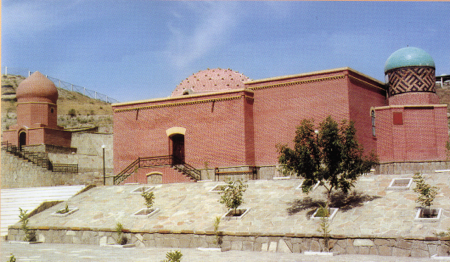 The architectural monument in the south-east of Nakhchivan city. Formed in 16- 18 centuries. Consists of 3 rooms. The base of the complex in plan is squareshaped, but outer view consists of the composition that the round base coming from the cubic formed towered tombs joining.The grave surface was built of a grave stone form, plastered with cement and covered with a black cloth. Having no epithaphic-grave inscription to appoint its belonging and view something about it was impossible. There was an inscription in the NW direction of the tomb in 20 years of the last century written in Naskh in Arabic. Though the date wasn't noted on the inscription but for the words Sultan Husein, the ruler of Safavi. This man as known II Shah Tahmasib during 1722-32 years was in power. So, the tomb was built in the 20s of the 18 century. The remnant of the second fortress wall existed in the Classical and Middle Ages in Nakhchivan near the tomb was discovered, craftsmen samples were found. The building joining the tomb, a bit bigger and having an entrance door from the west forms the central part. A bit far from the complex in the N direction there is another tomb. The tomb built of burnt bricks, from the down squareshaped and in the upper part was built of mul-tiangular shaped and its roof was covered with a dome. Compared with other constructions included to the complex this tomb was in a good order. But having not any inscription or grave inside its appointment was left uncertained. The buildings included in the Imamzadeh complex had harmony with one another and made a perfect architectural ensemble. There was a cemetery about the Middle Ages around the complex. From time to time some graves here were destroyed, but some others had been living up today. Grave inscriptions belonging to 16 century discovered from under the land had been investigated. Also spanshed vaults built of burnt bri-cks were come across here. Later on the place of the necropolis was changed and passed to the hill near the monument. Members of some mystic sects acting in the Middle Ages in this territory for a while had used of this complex to live, to pray, to resolve as a territory used the existing imamzadehs as places to live, to pray and to remember. That time there were not built settlements in the region. The architectural complex was capitally repaired and restored in 2004.
The architectural monument in the south-east of Nakhchivan city. Formed in 16- 18 centuries. Consists of 3 rooms. The base of the complex in plan is squareshaped, but outer view consists of the composition that the round base coming from the cubic formed towered tombs joining.The grave surface was built of a grave stone form, plastered with cement and covered with a black cloth. Having no epithaphic-grave inscription to appoint its belonging and view something about it was impossible. There was an inscription in the NW direction of the tomb in 20 years of the last century written in Naskh in Arabic. Though the date wasn't noted on the inscription but for the words Sultan Husein, the ruler of Safavi. This man as known II Shah Tahmasib during 1722-32 years was in power. So, the tomb was built in the 20s of the 18 century. The remnant of the second fortress wall existed in the Classical and Middle Ages in Nakhchivan near the tomb was discovered, craftsmen samples were found. The building joining the tomb, a bit bigger and having an entrance door from the west forms the central part. A bit far from the complex in the N direction there is another tomb. The tomb built of burnt bricks, from the down squareshaped and in the upper part was built of mul-tiangular shaped and its roof was covered with a dome. Compared with other constructions included to the complex this tomb was in a good order. But having not any inscription or grave inside its appointment was left uncertained. The buildings included in the Imamzadeh complex had harmony with one another and made a perfect architectural ensemble. There was a cemetery about the Middle Ages around the complex. From time to time some graves here were destroyed, but some others had been living up today. Grave inscriptions belonging to 16 century discovered from under the land had been investigated. Also spanshed vaults built of burnt bri-cks were come across here. Later on the place of the necropolis was changed and passed to the hill near the monument. Members of some mystic sects acting in the Middle Ages in this territory for a while had used of this complex to live, to pray, to resolve as a territory used the existing imamzadehs as places to live, to pray and to remember. That time there were not built settlements in the region. The architectural complex was capitally repaired and restored in 2004.
IMAMZADEH OF NEHRAM
The architectural monument of the 18 century in Nehram village, Babek region. Has been defended up today thereafter a lot changes, repair and restoration works. Being squareshaped in plan, hollows in the walls and the central room being covered with a dome shows that 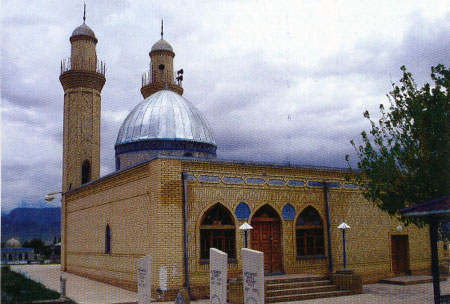 the monument belongs to the first mosque types. Even today, Imamzada of Nehram situating in the center of the cemetery where funerals are held is a big complex including a tomb, mosque, takya and other subsidiary buildings. Inside the tomb said to be a main part of the complex there is a grave, object of worship. Grave surface is in the form of a gravestone and plastered with lime and covered with a kerchief. Pilgrimas visit the grave, take vows and cut victims. There is no inscription to know who it belongs to. For the version spread among people, Seyid Agil, son of Imam Museyi Kazim, the seventh imam of shiah was buried in the grave. Sacred inscriptions have been written inside the tomb in the walls, in the south, head and right sides of the altar, in the domeshaped frames and also is shown that all calligraphy works belong to a craftsman by name Mehdi. Among the inscriptions "Call Ali, master of miracles!" written prayer is very attractive which belongs to the dervish of Baktashi. This writing shows that Imamzada of Nehram for some periods had displayed the function of a khanagah, and the dervish of Baktashi lived and acted here. The complex hasn't been investigated thoroughly.
the monument belongs to the first mosque types. Even today, Imamzada of Nehram situating in the center of the cemetery where funerals are held is a big complex including a tomb, mosque, takya and other subsidiary buildings. Inside the tomb said to be a main part of the complex there is a grave, object of worship. Grave surface is in the form of a gravestone and plastered with lime and covered with a kerchief. Pilgrimas visit the grave, take vows and cut victims. There is no inscription to know who it belongs to. For the version spread among people, Seyid Agil, son of Imam Museyi Kazim, the seventh imam of shiah was buried in the grave. Sacred inscriptions have been written inside the tomb in the walls, in the south, head and right sides of the altar, in the domeshaped frames and also is shown that all calligraphy works belong to a craftsman by name Mehdi. Among the inscriptions "Call Ali, master of miracles!" written prayer is very attractive which belongs to the dervish of Baktashi. This writing shows that Imamzada of Nehram for some periods had displayed the function of a khanagah, and the dervish of Baktashi lived and acted here. The complex hasn't been investigated thoroughly.
"ISMAYILKHAN" BATH-HOUSE
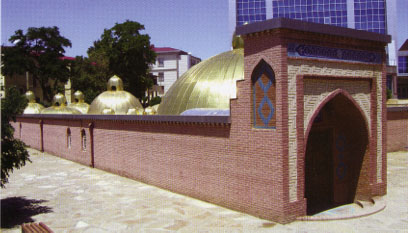 The historical architectural monument in Dade-Gorgud square, at the crossroads of H.Aliyev ave. and Tabriz str., Nakhchivan city. The bath-house built in the mid. of 18th century in the Eastern architectural style consists of an entrance, service hall, bathe place of pond, pond and a furnace. Total area is 526 m2. In plan rectangular. Built of burnt bricks in sizes 20x20x5 cm. Entrance to the bath-house is from the joinedspanned portal. Glazed exterior decoration. Entrance into the bathhouse is possible from a large vestibule, but to the cloakroom from the narrow passage. Cloakroom hall is an octagon shaped. Along the hall 6 recesses have been arranged. The bath hall has got two passages. One of the passages opens to another room. A pond of 2x2 m size was built in the center of the hall. The ceiling of the hall of 108 m2 was covered with a spherical dome. Lighting is by means of little windows arranged in the walls of the bath-house and smokeducts over the dome. The pond of the bath-house was arranged close to the bathing hall. The hole opened from the pond aimed for to take water. The water supply was through the Kehriz. The furnace under the pond played a great role in heating. The heat needed was provided by means of underground canals. The bath-house is linked with Ismayil khan, one of Nakhchivan khans. At present repaired and restored. As a historical-architectural monument it is defended by government.
The historical architectural monument in Dade-Gorgud square, at the crossroads of H.Aliyev ave. and Tabriz str., Nakhchivan city. The bath-house built in the mid. of 18th century in the Eastern architectural style consists of an entrance, service hall, bathe place of pond, pond and a furnace. Total area is 526 m2. In plan rectangular. Built of burnt bricks in sizes 20x20x5 cm. Entrance to the bath-house is from the joinedspanned portal. Glazed exterior decoration. Entrance into the bathhouse is possible from a large vestibule, but to the cloakroom from the narrow passage. Cloakroom hall is an octagon shaped. Along the hall 6 recesses have been arranged. The bath hall has got two passages. One of the passages opens to another room. A pond of 2x2 m size was built in the center of the hall. The ceiling of the hall of 108 m2 was covered with a spherical dome. Lighting is by means of little windows arranged in the walls of the bath-house and smokeducts over the dome. The pond of the bath-house was arranged close to the bathing hall. The hole opened from the pond aimed for to take water. The water supply was through the Kehriz. The furnace under the pond played a great role in heating. The heat needed was provided by means of underground canals. The bath-house is linked with Ismayil khan, one of Nakhchivan khans. At present repaired and restored. As a historical-architectural monument it is defended by government.
JAME MOSQUE IN NAKHCHIVAN
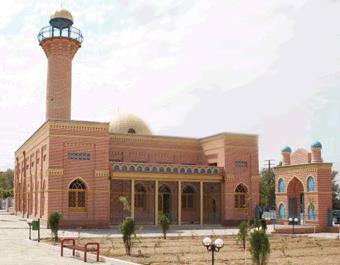 The architectural monument in Nakhchivan city. According to its architectural-constructive structure the mosque is related to 18 cent. The inscription was installed on the top of the entrance door. The inscription written in nastalig hand writing on the marble plate (87 x 57cm) in arabic and Persian starting with the religion text says that this Jafariyya mosque was restored in 1311 (1894) by Kheyrul-Haj Mahammad Jafar oglu, the son of late Haji Novruz. Also it was noted that Haji Mahammad Jafar Agha had appointed 2 shops over the river for to supply the expenses of the mosque and the servants working there under "Chay yukharisinda" (at over river) Bazar river is meant which one time was floating from north-east and joining with the Araz in the south-west and crossing the mid. of Nakhchivan city. This river had been floating up to 60 years of 20 hundred through Nakhchivan city. In 60 years the river was covered with concrete blocks and became unseen. The architect of the mosque introduces himself in the inscription as: "If after me they will seek the architect of the mosque, I am named by the name after the eighth imam". It is an obvious fact that the eighth imam of shiahs is Rza, but the ninth imam’s Mahammad Tagi. So, the architect of the mosque was Mahammad Tagi. By means of this inscription the names of two great skillful masters unknown to people were engaged to the scientific circulation. One of them is Mahammad Tagi (he had written the context of the inscription on a marble plate, too), but the second is Mahammad Saleh who had engraved the inscription. The total area of the mosque is about 1000m2. One minaret. In 1918 when Armenians committed genocide against local people in Nakhchivan they damaged the minaret by artillery fire. The minaret was restored later on. It was the only mosque that continued its activity in Nakhchivan city, generally in the autonomous republic during the soviet Power. In 2007 capital restoration works were held in the mosque.
The architectural monument in Nakhchivan city. According to its architectural-constructive structure the mosque is related to 18 cent. The inscription was installed on the top of the entrance door. The inscription written in nastalig hand writing on the marble plate (87 x 57cm) in arabic and Persian starting with the religion text says that this Jafariyya mosque was restored in 1311 (1894) by Kheyrul-Haj Mahammad Jafar oglu, the son of late Haji Novruz. Also it was noted that Haji Mahammad Jafar Agha had appointed 2 shops over the river for to supply the expenses of the mosque and the servants working there under "Chay yukharisinda" (at over river) Bazar river is meant which one time was floating from north-east and joining with the Araz in the south-west and crossing the mid. of Nakhchivan city. This river had been floating up to 60 years of 20 hundred through Nakhchivan city. In 60 years the river was covered with concrete blocks and became unseen. The architect of the mosque introduces himself in the inscription as: "If after me they will seek the architect of the mosque, I am named by the name after the eighth imam". It is an obvious fact that the eighth imam of shiahs is Rza, but the ninth imam’s Mahammad Tagi. So, the architect of the mosque was Mahammad Tagi. By means of this inscription the names of two great skillful masters unknown to people were engaged to the scientific circulation. One of them is Mahammad Tagi (he had written the context of the inscription on a marble plate, too), but the second is Mahammad Saleh who had engraved the inscription. The total area of the mosque is about 1000m2. One minaret. In 1918 when Armenians committed genocide against local people in Nakhchivan they damaged the minaret by artillery fire. The minaret was restored later on. It was the only mosque that continued its activity in Nakhchivan city, generally in the autonomous republic during the soviet Power. In 2007 capital restoration works were held in the mosque.
JAME MOSQUE IN ORDUBAD
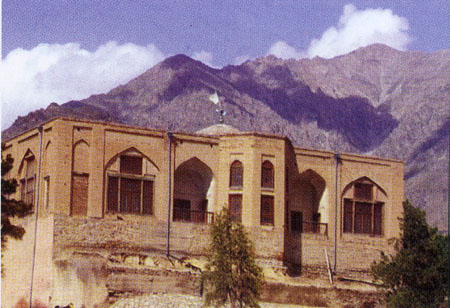 The architectural monument about the Middle Ages in Ordubad city. The mosque built in the highest place of the center of the city attracts attention for its grandiose structure. The architectural figure of the mosque nowadays is bearing the key features of the monuments belonging to 17-18 centuries. On the stone plate on the door to the east of the Juma mosque. the decree of five lines by shah Abbas I was engraved in naskh handwriting in persian. The decree belonging to 1604 says: "As all Ordubad people's estimation to the family of shah Abbas Bahadur Khan and the reality of heroism clearing up, and their being rooty shiah, during occupation the regions of Azerbaijan by the enemies and their being tortured differently by the invaders, a many of them being killed and taken hostages, generally their being heroic, specially for the great Nasriyya-Tusiyya generation, a part of mercy of shah was gifted to the people of Ordubad. From the date as the province was included to the leadership of a very tactful government the inhabitants of the stated settlement were freed from the craftsmen goods, gardens, arable lands, mills tax payments, also the duties are export, import, nuzul, problem committing, gongalga payments were abolished for God's sake to earn the estimate of God and also it was declared exceptionally that in the territory of Azerbaijan the payment to be paid from the state treasure…" The plan structure of the mosque, some elements and its artistic arrangement shows that it was very old in its first form. It is expected that the mosque was repaired in 17 century. The geometric ornaments on the inside walls of the mosque remind us the designs in the old monuments of Nakhchivan. During the restoration works held in 1901-02 in the mosque the writing on the brick found shows that it was built in 111 by hijri calendar (729 chr.). Before there were caravansaries, shops in the square to the s of the mosque. That time this square and the mosque area made one complex. The investigators state that the present appearance of the Jame mosque is the result of later additions. Today the madrasa building is situated in the north east and in the west Zorkhana of the mosque. The mosque and buildings around were capitally repaired in 1987.
The architectural monument about the Middle Ages in Ordubad city. The mosque built in the highest place of the center of the city attracts attention for its grandiose structure. The architectural figure of the mosque nowadays is bearing the key features of the monuments belonging to 17-18 centuries. On the stone plate on the door to the east of the Juma mosque. the decree of five lines by shah Abbas I was engraved in naskh handwriting in persian. The decree belonging to 1604 says: "As all Ordubad people's estimation to the family of shah Abbas Bahadur Khan and the reality of heroism clearing up, and their being rooty shiah, during occupation the regions of Azerbaijan by the enemies and their being tortured differently by the invaders, a many of them being killed and taken hostages, generally their being heroic, specially for the great Nasriyya-Tusiyya generation, a part of mercy of shah was gifted to the people of Ordubad. From the date as the province was included to the leadership of a very tactful government the inhabitants of the stated settlement were freed from the craftsmen goods, gardens, arable lands, mills tax payments, also the duties are export, import, nuzul, problem committing, gongalga payments were abolished for God's sake to earn the estimate of God and also it was declared exceptionally that in the territory of Azerbaijan the payment to be paid from the state treasure…" The plan structure of the mosque, some elements and its artistic arrangement shows that it was very old in its first form. It is expected that the mosque was repaired in 17 century. The geometric ornaments on the inside walls of the mosque remind us the designs in the old monuments of Nakhchivan. During the restoration works held in 1901-02 in the mosque the writing on the brick found shows that it was built in 111 by hijri calendar (729 chr.). Before there were caravansaries, shops in the square to the s of the mosque. That time this square and the mosque area made one complex. The investigators state that the present appearance of the Jame mosque is the result of later additions. Today the madrasa building is situated in the north east and in the west Zorkhana of the mosque. The mosque and buildings around were capitally repaired in 1987.
JULFA CARAVANSARY
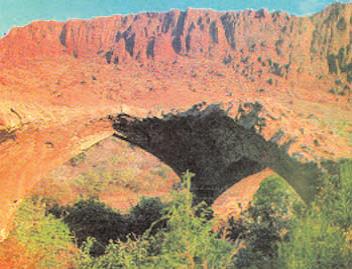 The architectural monument on the left bank of the Araz river, in Gulustan village, Julfa region. The remainder of Julfa caravansary was discovered in 1974 during field-investigation works. The plan of the building was completely discovered in 1978. During Baki-Julfa railway construction about half of the caravansary was destroyed. In the process of investigation it also was as certain that Julfa caravansary was one of the grandiose and eminent one among the way caravansary in Azerbaijan. The caravansary of the same type of Julfa caravansary of total length 37 m is on the right side of the Araz river, almost undestroyed. The caravansaries on both sides opposing prove that the bridge construction over the Araz river raft activity existed and the date of the caravansaries' construction back to beginning of 13 century. The caravansaries were built of stones and plastered with lime material. In the discovered part of Julfa caravansary there are a lot of rooms. The roofs of some rooms have a very interesting construction. There is a big hall to the north of the building having deep wall hollows in a span form on both-right and left sides. To arrive at a concrete idea about this hall is difficult, but there exist the old mosques having this type of plan structure.
The architectural monument on the left bank of the Araz river, in Gulustan village, Julfa region. The remainder of Julfa caravansary was discovered in 1974 during field-investigation works. The plan of the building was completely discovered in 1978. During Baki-Julfa railway construction about half of the caravansary was destroyed. In the process of investigation it also was as certain that Julfa caravansary was one of the grandiose and eminent one among the way caravansary in Azerbaijan. The caravansary of the same type of Julfa caravansary of total length 37 m is on the right side of the Araz river, almost undestroyed. The caravansaries on both sides opposing prove that the bridge construction over the Araz river raft activity existed and the date of the caravansaries' construction back to beginning of 13 century. The caravansaries were built of stones and plastered with lime material. In the discovered part of Julfa caravansary there are a lot of rooms. The roofs of some rooms have a very interesting construction. There is a big hall to the north of the building having deep wall hollows in a span form on both-right and left sides. To arrive at a concrete idea about this hall is difficult, but there exist the old mosques having this type of plan structure.
KHAN PALACE
The historical architectural monument about 18 century, Nakhchivan city. The monument built in Eastern architectural style was a settlement house of Nakhchivan khans up to the beginning of 20 century. The palace was built by Kalbali khan Kangarli, father of Ehsan khan who was the last Nakhchivan khan at the end of 18 century. The Khan Palace was built in the west direction of the palace complex having 3600 m2 area, facing to the sunrise direction according to the relief of khan diki (hilly land). There is 42 x 8 in size a subsidiary building, newly built pond, water well, greenness, decorative and wild trees in the complex of the Khan Palace. The building is two storeyed. Before the palace was of two separate departments. The south department was considered for administrative affairs, receiving the senior ranking guests, but the north department was aimed for the khan family to live in. Entrance to the departments was from the two storeyed balcony shaped, a joined spanned corridor. At present a museum being situated in the palace only the southern corridor is used of. An inside passage was established among the departments. 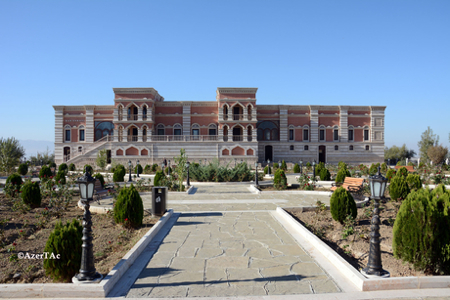 Since the corridors have been projected ahead of facade it gives a specific beauty to the building. By means of the stairs decorated with red sand stone people go to the halls. Around the stairs were built of bricks and strengthened with wooden lattices. The total area of the Khan Palace is 382 m2, the walls thickness is between 60 cm to 1,1 m changes. The building was built of burnt bricks 20 x 20 x 5 cm in size. The lattice style was used in the windows and in all rooms there were installed recesses of different sizes specific for Nakhchivan houses. There are 3 rooms on the ground floor, 8 rooms on the first floor (2 halls) and there are situated 2 mansards over the vestibules used as rooms. From both mansards there is an entrance to the open balcony over the corridors. They go upstairs to the mansards from the brick stairs opened in the vestibules. The south hall of the Khan Palace is very luxurious. A couch of stage typed was established 40 cm in height from the floor in the west of the hall for to receive the guests. The windows of the couched corner were latticed from floor to ceiling, but the ceiling was designed with small mirror pieces very neatly. The other walls have been worked with recesses, natural and plotty drawings. During several repair and restoration works held later on the drawings were obliterated or their surfaces were covered with plastering. The fire-place decorated with mirror pieces, geometric forms around situated in the south wall make the hall more magnificent. The house was heated by means of two fire-places established in the walls. Starting from April, 1998 the Khan Palace has been acting as Nakhchivan State Carpet Museum. The museum consists of 8 halls, one of them was dedicated to the khans of Nakhchivan. In the time of establishment there were only 359 expositions, but today the number of them is more than 2000 (305 carpets). Almost all kinds of carpet samples-fleecy, carpet, shady, and unfleecy; (sumakh, varni, kilim, unpiled carpet, shadde, jejim and so on) and carpet products (holdall, saddle-bag, carpet bag, sack, belt and so on) are exhibited here. The carpet samples belonging to Ganja-Gazakh, Guba-Shirvan, Garabagh, Tabriz- Nakhchivan carpet schooling are kept in the museum. For their knots together with "Gollu chichi", "Pirabadil", "Alpan", "Gadim afshan", "Ovchulug", "Zilli", "Kohna buta", "Nakhchivan", "Gasimushaghi" etc. carpets, the plotty carpets (the carpet weaved the portrait of Heydar Aliyev, national leader of the Azerbaijan people on (People's Artist K. Aliyev), "Leyli and Majnun", "Garabagh scape", "Boz gurdlar", "Ganja gozali" etc) are having great importance. Also home things-copper-smith samples, pottery and clay tablewares, old men and women clothes are exhibited in the museum.
Since the corridors have been projected ahead of facade it gives a specific beauty to the building. By means of the stairs decorated with red sand stone people go to the halls. Around the stairs were built of bricks and strengthened with wooden lattices. The total area of the Khan Palace is 382 m2, the walls thickness is between 60 cm to 1,1 m changes. The building was built of burnt bricks 20 x 20 x 5 cm in size. The lattice style was used in the windows and in all rooms there were installed recesses of different sizes specific for Nakhchivan houses. There are 3 rooms on the ground floor, 8 rooms on the first floor (2 halls) and there are situated 2 mansards over the vestibules used as rooms. From both mansards there is an entrance to the open balcony over the corridors. They go upstairs to the mansards from the brick stairs opened in the vestibules. The south hall of the Khan Palace is very luxurious. A couch of stage typed was established 40 cm in height from the floor in the west of the hall for to receive the guests. The windows of the couched corner were latticed from floor to ceiling, but the ceiling was designed with small mirror pieces very neatly. The other walls have been worked with recesses, natural and plotty drawings. During several repair and restoration works held later on the drawings were obliterated or their surfaces were covered with plastering. The fire-place decorated with mirror pieces, geometric forms around situated in the south wall make the hall more magnificent. The house was heated by means of two fire-places established in the walls. Starting from April, 1998 the Khan Palace has been acting as Nakhchivan State Carpet Museum. The museum consists of 8 halls, one of them was dedicated to the khans of Nakhchivan. In the time of establishment there were only 359 expositions, but today the number of them is more than 2000 (305 carpets). Almost all kinds of carpet samples-fleecy, carpet, shady, and unfleecy; (sumakh, varni, kilim, unpiled carpet, shadde, jejim and so on) and carpet products (holdall, saddle-bag, carpet bag, sack, belt and so on) are exhibited here. The carpet samples belonging to Ganja-Gazakh, Guba-Shirvan, Garabagh, Tabriz- Nakhchivan carpet schooling are kept in the museum. For their knots together with "Gollu chichi", "Pirabadil", "Alpan", "Gadim afshan", "Ovchulug", "Zilli", "Kohna buta", "Nakhchivan", "Gasimushaghi" etc. carpets, the plotty carpets (the carpet weaved the portrait of Heydar Aliyev, national leader of the Azerbaijan people on (People's Artist K. Aliyev), "Leyli and Majnun", "Garabagh scape", "Boz gurdlar", "Ganja gozali" etc) are having great importance. Also home things-copper-smith samples, pottery and clay tablewares, old men and women clothes are exhibited in the museum.
KHANAGAH TOMB
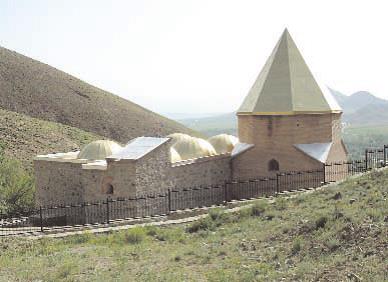 The architectural monument about the Middle Ages, on the bank of the Alinjachay, in Khanagah village, Julfa region. It is in the place of the Middle Age Khanagah settlement. The stone inscription that fell down from the tomb door place is kept inside the tomb. The inscription says that the tomb was built for Amirkhan in the period of Garagoyunlu Jahan shah (1435-67), son of sahib al-zaman (vezir) Haji Mahammad, son of martyr emir Seyyid Ahmad al-Oghul-Shamin. The architectural elements of the entrance headspan look like the elements of Momuna Khatun tomb. The tomb in the vault plan was in a rightangle form and built of stone and brick. Lime material solution was used as an enforcement.
The architectural monument about the Middle Ages, on the bank of the Alinjachay, in Khanagah village, Julfa region. It is in the place of the Middle Age Khanagah settlement. The stone inscription that fell down from the tomb door place is kept inside the tomb. The inscription says that the tomb was built for Amirkhan in the period of Garagoyunlu Jahan shah (1435-67), son of sahib al-zaman (vezir) Haji Mahammad, son of martyr emir Seyyid Ahmad al-Oghul-Shamin. The architectural elements of the entrance headspan look like the elements of Momuna Khatun tomb. The tomb in the vault plan was in a rightangle form and built of stone and brick. Lime material solution was used as an enforcement.
KOHNAGALA
The archaeological monument in the south-east of Nakhchivan city. Yazdagird in scientific literature, among people known by the names of Kohna gala, Torpaggala. Exact date of the construction is unknown. During archaeological investigations around the fortress in 1957 -1959 very rich archaeological materials, of which specially earthenware typed fragments, stone maces, were discovered. It is a fact from the archaeological investigations that these types of stone maces were used in the salt mines in the Bronze Age (3-2 millennium B.C.) 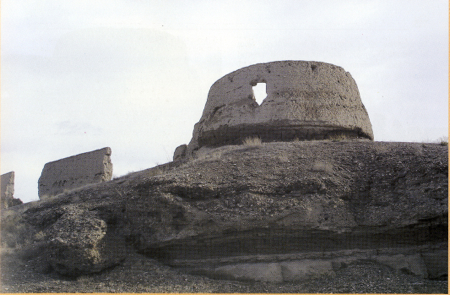 The fortress is expected to be built by Yazdagir, the third Sasani ruler (632-51/52). For O.Chalabi, a Turkish traveler, the mongols had destroyed the fortress. Sharden and Frehang who later on were in Nakhchivan also remind the fortress. The fortress was in use up to the 18 century. This fortress was noted schematically in the plan of 1827. For the plan the fortress consists of two parts-little fortress (Naringala) and big fortress. Compared with Naringala the Boyukgala had undergone more destructions. The territory of rightangle form of Boyukgala (185x400 m) is 7400 m2. The undestroyed walls of the fortress built of pressed clay and sand solution and being built of bricks burnt in yellow and pink colour of a square form (19x19x5 cm), expected repaired later on compared with Naringala and remnants of buildings built of bricks prove that it is about the Middle Ages. Boyukgala was built according to the relief of the hill it is situated; a bit straight from the north-east and north-west but from the south direction in zig-zag form. The diameter projection joining to the outer side of zig-zags was completed with the changeable conic towers from 5,7 m-to 9 m. The width of the undestroyed walls of Boyukgala is 1 m, but the height reaches to 5 m. In addition, it is better to state that the tomb of Noah in the west corner and remnants of other constructions remain in the fortress. In north part of the fortress of a square form (150x150 m) at present remain the traces of buildings. The thickness of the undestroyed walls of Naringala built of pressed clay with stone solution is between 3,5 m-4 m. Naringala possesses roundshaped towers of 10 m. diameters. It is supposed that the gate of Naringala was side by side with the tower of its west corner. The walls surrounding Naringala remained undestroyed in the west part of the fortress. The roundshaped towers in the direction of the north-east getting narrower in the upper parts have reached to our time nearly undestroyed. There is an underground shelter to the south-west of Naringala for the capacity of 300 people. There was opened a hole for ventilation and lighting in the upper part. The secret way from the cave toward the north of the fortress, very likely goes to Nakhchivanchay. Two wells of the kehriz passing beneath under Naringala are situated inside the fortress. One of the wells is in the cave. One of the most specifities of the fortress is the arrangement between Boyukgala and main Naringala distance of 22,5 m. in width in a narrow corridor shaped "trap". Though the fortress had been destroyed but the undestroyed parts of the fortress walls attract attention.
The fortress is expected to be built by Yazdagir, the third Sasani ruler (632-51/52). For O.Chalabi, a Turkish traveler, the mongols had destroyed the fortress. Sharden and Frehang who later on were in Nakhchivan also remind the fortress. The fortress was in use up to the 18 century. This fortress was noted schematically in the plan of 1827. For the plan the fortress consists of two parts-little fortress (Naringala) and big fortress. Compared with Naringala the Boyukgala had undergone more destructions. The territory of rightangle form of Boyukgala (185x400 m) is 7400 m2. The undestroyed walls of the fortress built of pressed clay and sand solution and being built of bricks burnt in yellow and pink colour of a square form (19x19x5 cm), expected repaired later on compared with Naringala and remnants of buildings built of bricks prove that it is about the Middle Ages. Boyukgala was built according to the relief of the hill it is situated; a bit straight from the north-east and north-west but from the south direction in zig-zag form. The diameter projection joining to the outer side of zig-zags was completed with the changeable conic towers from 5,7 m-to 9 m. The width of the undestroyed walls of Boyukgala is 1 m, but the height reaches to 5 m. In addition, it is better to state that the tomb of Noah in the west corner and remnants of other constructions remain in the fortress. In north part of the fortress of a square form (150x150 m) at present remain the traces of buildings. The thickness of the undestroyed walls of Naringala built of pressed clay with stone solution is between 3,5 m-4 m. Naringala possesses roundshaped towers of 10 m. diameters. It is supposed that the gate of Naringala was side by side with the tower of its west corner. The walls surrounding Naringala remained undestroyed in the west part of the fortress. The roundshaped towers in the direction of the north-east getting narrower in the upper parts have reached to our time nearly undestroyed. There is an underground shelter to the south-west of Naringala for the capacity of 300 people. There was opened a hole for ventilation and lighting in the upper part. The secret way from the cave toward the north of the fortress, very likely goes to Nakhchivanchay. Two wells of the kehriz passing beneath under Naringala are situated inside the fortress. One of the wells is in the cave. One of the most specifities of the fortress is the arrangement between Boyukgala and main Naringala distance of 22,5 m. in width in a narrow corridor shaped "trap". Though the fortress had been destroyed but the undestroyed parts of the fortress walls attract attention.
MIRANSHAH SACRED PLACE
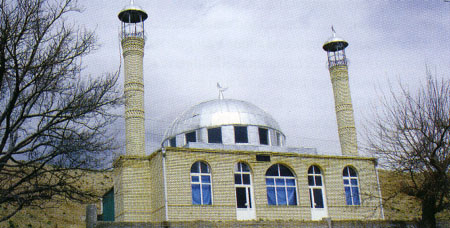 It situates on the slope of a high hill, in the east from Garagala village, Babek region. Before the sacred place was inside the stone excavation and related to a stone belief. Inside mosque is an improper squareshaped form. There are two graves buried to Muslim tradition. No writing on the headstone. At present the sacred place has been restored and a monumental monument similar to a Muslim mosques was built on it. Inside the sacred place was columned and mainly divided into parts. Two minarets of cylindric form and its dome were completed with halfmoon descriptions. Old trusts and mythologic views of the Azerbaijani people enable us to say that Miranshah sacred place relates to the 3-2 millennium B.C.
It situates on the slope of a high hill, in the east from Garagala village, Babek region. Before the sacred place was inside the stone excavation and related to a stone belief. Inside mosque is an improper squareshaped form. There are two graves buried to Muslim tradition. No writing on the headstone. At present the sacred place has been restored and a monumental monument similar to a Muslim mosques was built on it. Inside the sacred place was columned and mainly divided into parts. Two minarets of cylindric form and its dome were completed with halfmoon descriptions. Old trusts and mythologic views of the Azerbaijani people enable us to say that Miranshah sacred place relates to the 3-2 millennium B.C.
MOMUNA KHATUN TOMB
The historical architectural monument in Nakhchivan city. A grandiose monument of Azerbaijan national architecture, one of the pearls of the Eastern architecture. Was built in the west part of Nakhchivan city in 1186. (architect Ajami Abubakir oglu Nakhchivani). Shamsaddin Eldaniz, founder of Azerbaijan the Atabay state decided to erect a tomb on the grave of his wife Momuna khatun and Mahammad Jahan Pahlavan, son of Shamsaddin Eldaniz completed its construction in 582 A.H., on maharram month (April, 1186). People remember this monument as "Atabay Tomb". On the headspan these words have been written in Cufic writing: "After us but is left wind. After our death our works remain as present". Total height was 34 m, but later on its outer cover of 8 m in height was destroyed. The tomb consists of under ground (vault) and overground parts. In plan the vault part is tenshaped. According to some investigators shamsaddin Eldaniz, ruler 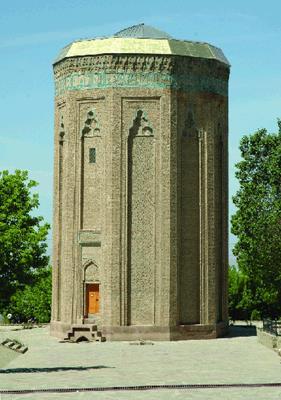 of Atabaylar state, his wife Momuna khatun and son Mahammad Jahan Pahlavan were buried in the vault. Whenever the he adstones of those who were buried in the vault had been robbed. In 2003 there was held a restoration work of precious stone neatily. The vault having original structure possesses a rich design arrangement. The column situating in the center joins with each corner of decagon in a spannedform. This structure in the vault later on was implemented in the west, in gothic architecture. The overground part of the tomb is decagon (surrounded with Cunic inscriptions on either side) but inside is roundshaped. There are four rounded lockets where the names of caliphs inside the dome are baked. The corners of Momuna khatun tomb built of burnt bricks was completed with projection forms, but the surfaces in a hollow form. The corner projections of the tomb were covered with the inscriptions written in Cufic. The length of these inscriptions reach to 500 m. The tomb surface structure was designed with turquoise glazed tiles consisting of geometrical ornaments composition and had enriched widely. The west part of the tomb is differed for its design features. In this point the surface has been divided into two parts-down part entrance door in a span form, but in the upper part has been completed with ornamental designs. The inscriptions showing the name of architect and date of tomb construction was engraved in the upper part of the headspan. Simple systemed inside surface of the tomb was plastered with clay and inside the dome was decorated with designs of 4 medallions. For its composition, perfectness, neatiness of separations, being worked neatly and architectural solution the tomb is considered one of the architectural masterpieces of the Middle Ages. M.V.Alpatov, popular historian of art, full member of the USSR Academy of Arts writes about the tomb: "The tomb of Momuna khatun erected in the 12 century in Nakhchivan by the Azerbaijan masters is a monument of a rare beauty and neatiness. The Momuna khatun tomb is eternal as the most magnificient classic works in the East-like the "shahname" of Firdovsi and "Leyli and Majnun" by Nizami. For Alpatov even in that period Middle Europe architecture to meet such a beautiful monument is impossible. Together with its grandiose architectural richness the monument demonstrates the old history of Azerbaijan, its mighty stateshipness, high leveled culture and great architectural schooling of Azerbaijan. In the photos and paintings of the 19 century one can see that around Momuna khatun tomb there were monumental buildings inclusively Jame mosque as well.
of Atabaylar state, his wife Momuna khatun and son Mahammad Jahan Pahlavan were buried in the vault. Whenever the he adstones of those who were buried in the vault had been robbed. In 2003 there was held a restoration work of precious stone neatily. The vault having original structure possesses a rich design arrangement. The column situating in the center joins with each corner of decagon in a spannedform. This structure in the vault later on was implemented in the west, in gothic architecture. The overground part of the tomb is decagon (surrounded with Cunic inscriptions on either side) but inside is roundshaped. There are four rounded lockets where the names of caliphs inside the dome are baked. The corners of Momuna khatun tomb built of burnt bricks was completed with projection forms, but the surfaces in a hollow form. The corner projections of the tomb were covered with the inscriptions written in Cufic. The length of these inscriptions reach to 500 m. The tomb surface structure was designed with turquoise glazed tiles consisting of geometrical ornaments composition and had enriched widely. The west part of the tomb is differed for its design features. In this point the surface has been divided into two parts-down part entrance door in a span form, but in the upper part has been completed with ornamental designs. The inscriptions showing the name of architect and date of tomb construction was engraved in the upper part of the headspan. Simple systemed inside surface of the tomb was plastered with clay and inside the dome was decorated with designs of 4 medallions. For its composition, perfectness, neatiness of separations, being worked neatly and architectural solution the tomb is considered one of the architectural masterpieces of the Middle Ages. M.V.Alpatov, popular historian of art, full member of the USSR Academy of Arts writes about the tomb: "The tomb of Momuna khatun erected in the 12 century in Nakhchivan by the Azerbaijan masters is a monument of a rare beauty and neatiness. The Momuna khatun tomb is eternal as the most magnificient classic works in the East-like the "shahname" of Firdovsi and "Leyli and Majnun" by Nizami. For Alpatov even in that period Middle Europe architecture to meet such a beautiful monument is impossible. Together with its grandiose architectural richness the monument demonstrates the old history of Azerbaijan, its mighty stateshipness, high leveled culture and great architectural schooling of Azerbaijan. In the photos and paintings of the 19 century one can see that around Momuna khatun tomb there were monumental buildings inclusively Jame mosque as well.
NAKHCHIVAN ICE-HOUSE
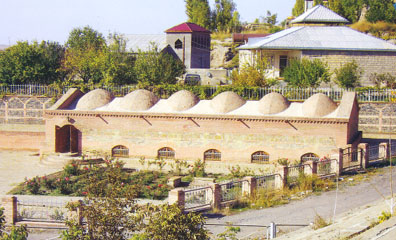 The architectural monument near Imamzadeh complex, in Nakhchivan city. One of the biggest ice-houses in the Republic of Azerbaijan. The ice-house of a rightangle form in plan is 20 m at length, 9 m in width and at present 9,6 m at height. A perfect solution of a cover construction, built of technically very qualified bricks, being built in nature, longside, light and dynamic construction scheme style of a roof cover are characteristic features of north ice-house. Joinedspanned interspan space built at every 3 m was covered with joined arches. Brick lay lines were arranged vertically compared with supporting spans. As it is seen of brick layings of the building cover the construction of arches on the upper part of spans changed and are completed with little arches. These little arches were arranged along the main axis of the building. An ice house of its alike in the territory of Azerbaijan is in Ordubad city. Very high architectural solution of Nakhchivan icehouse shows that it was built during Nakhchivan architectural schooling development (12-14 centuries).
The architectural monument near Imamzadeh complex, in Nakhchivan city. One of the biggest ice-houses in the Republic of Azerbaijan. The ice-house of a rightangle form in plan is 20 m at length, 9 m in width and at present 9,6 m at height. A perfect solution of a cover construction, built of technically very qualified bricks, being built in nature, longside, light and dynamic construction scheme style of a roof cover are characteristic features of north ice-house. Joinedspanned interspan space built at every 3 m was covered with joined arches. Brick lay lines were arranged vertically compared with supporting spans. As it is seen of brick layings of the building cover the construction of arches on the upper part of spans changed and are completed with little arches. These little arches were arranged along the main axis of the building. An ice house of its alike in the territory of Azerbaijan is in Ordubad city. Very high architectural solution of Nakhchivan icehouse shows that it was built during Nakhchivan architectural schooling development (12-14 centuries).
NOAH TOMB
The architectural monument about 8-12 centuries, in the territory named Kohnagala to the south of Nakhchivan city. In the article "Nakhchivan city and Nakhchivan Uyezd" written by K.A. Nikitin, the grave and tomb of prophet Noah in this land were described as: "Grave of Noah is situated in the south direction of Nakhchivan city, near the remnants of the ancient fortress. Present view of the grave was res to red in the 8th century. Today's grave indicates a tomb above the ground surface, not bigger. Before there was a temple, but then destroyed. Today's tomb consists of the remnants of the lower floor of the former temple. The interior of the stair for to go down is roundformed and looks like a vault enforced in the middle with a stone pole. According to the legend, the grave of Noah is under the right pole. There are no images or decorations in the vault. Vault walls had been whitened and the names of tourists and travellers coming to pilgrimage had been written in different languages on the walls. V.M. Sisoyev in his work "Tomb of Noah" stated that the sides of the vault were eight-pointed prismlike of 2,5 m. Bahruz Kangarli (1892- 1922), founder of Azerbaijan realist work of arts painted the tomb of Noah from nature in oil paint at the beginning of 20th century which is in Nakhchivan city. Together with the Noah Tomb the territory where the tomb is situated was described in the work. There are a lot of versions about Noah in Nakhchivan. For the legend, during the world storm, 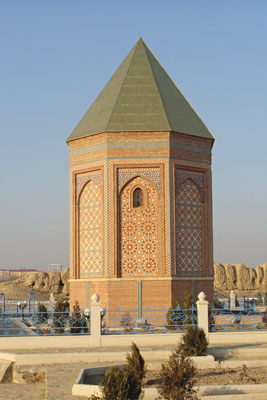 the ark of Hazrati (Excellency) Noah prophet had touched to Ilandagh in Nakhchivan and dropped anchor near Gapichig Top. Naming that place as Gamigaya, being Nabi land summer pasture and existence of Nuhdaban settlement around, give an opportunity to say that all retold facts are to reality. Even in the versions about the prophet Noah, there is a lot of information about his own and his sister's graves being in Nakhchivan city. I.Shopen, Dyubuade Monpere, K.A. Nikitin, V.M. Sisoyev and other investigators have given information about Noah's tomb being in Nakhchivan. It was K.A.Nikitin (1832-1894), Russian educationalist who lived and worked in Nakhchivan in 80 years of the 19 century, with the help of the local people, gathered materials about prophet Noah, wrote it and ascertained the place of his grave, what kind of relations prophet Noah had with this ancient land. Nikitin in his article "Nakhchivan city and Nakhchivan Uyezd", published in the collection of "Materials for description Nakhchivan country and its tribes" in 1882, gave thorough information about it. "...Hereafter Noah lived in Nakhchivan, died and was buried here. Even nowadays his grave and place of tomb are shown by people. Even there are versions that one time Noah had worked in the salt mines and people speak about his the then activity through legends. For legends, he was one of the first who had worked here... He had lived here together with his family and laid the foundation of the future city. Name of Nakhchivan city having the meaning of the first settlement, appeared as a result of this. For the legends, a human stock had spread from here. Even today there are versions and expectations about the remnants of Noah's ark being in Gamigaya. On the bases of 28 June 2006 order “About restoration the grave tomb of prophet Noah in Nakhchivan city” signed by V.Talibov, Chairman of Supreme Majlis of Nakhchivan Autonomous Republic, during 2007-2008years it was restored and construction works were held in the territory considering the historical sources.
the ark of Hazrati (Excellency) Noah prophet had touched to Ilandagh in Nakhchivan and dropped anchor near Gapichig Top. Naming that place as Gamigaya, being Nabi land summer pasture and existence of Nuhdaban settlement around, give an opportunity to say that all retold facts are to reality. Even in the versions about the prophet Noah, there is a lot of information about his own and his sister's graves being in Nakhchivan city. I.Shopen, Dyubuade Monpere, K.A. Nikitin, V.M. Sisoyev and other investigators have given information about Noah's tomb being in Nakhchivan. It was K.A.Nikitin (1832-1894), Russian educationalist who lived and worked in Nakhchivan in 80 years of the 19 century, with the help of the local people, gathered materials about prophet Noah, wrote it and ascertained the place of his grave, what kind of relations prophet Noah had with this ancient land. Nikitin in his article "Nakhchivan city and Nakhchivan Uyezd", published in the collection of "Materials for description Nakhchivan country and its tribes" in 1882, gave thorough information about it. "...Hereafter Noah lived in Nakhchivan, died and was buried here. Even nowadays his grave and place of tomb are shown by people. Even there are versions that one time Noah had worked in the salt mines and people speak about his the then activity through legends. For legends, he was one of the first who had worked here... He had lived here together with his family and laid the foundation of the future city. Name of Nakhchivan city having the meaning of the first settlement, appeared as a result of this. For the legends, a human stock had spread from here. Even today there are versions and expectations about the remnants of Noah's ark being in Gamigaya. On the bases of 28 June 2006 order “About restoration the grave tomb of prophet Noah in Nakhchivan city” signed by V.Talibov, Chairman of Supreme Majlis of Nakhchivan Autonomous Republic, during 2007-2008years it was restored and construction works were held in the territory considering the historical sources.
THE TOMB OF USIF KUSEYIR OGLU
An architectural monument in Nakhchivan city. This monument situated in the street of sheykh Mahammad Khiyabani is also called as Atababa tomb or Atababa dome by people. The tomb of more than 8 centuries was restored in the middle of the 20 century. As a result of restoration works the destroyed parts of the tomb were restored and engineering installations were enforced. The monument consist, of underground vault and overground towerformed part. In plan the overground of the monument is octagonial both inside and outside. The thickness of walls is 80 cm. Constructed of burnt bricks 20x20x 4,5 cm. The prismatic octagonal basement of the tomb was covered with pyramidshaped brick dome outside, but from inside the ceiling was covered with a join spanned spheric dome. We see the only example of the double dome structure in the tomb being very great, saving its initial form and reaching to our time. It is the result of mastery engineering that Usif Kuseyir oglu tomb is the only tomb having upper pyramidial cover and remaining understroyed during 800 years among the towerformed tombs in Azerbaijan. The inscription on the tomb predicts that, "This tomb belongs to Usif Kuseyir oglu, leader of 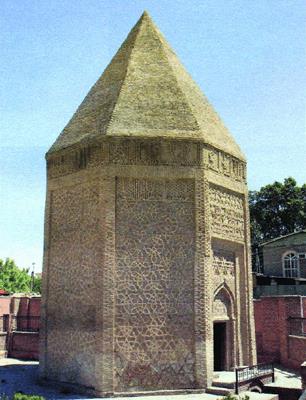 sheikhs, beautiness of Islam, intellect of religion, distinguished chief and khaja". The very inscription also predicts that the tomb was built in 557 by hijri calendar, month of shavval (christ. 1162). But in the inscription to the left of the main facade the name of an architect "Deed of Ajami Abubakr oglu Nakhchivani, builder" was stated. The upper part of the faces of the tomb was separated as a belt and an inscription was arranged there. In that belt sentences from Koran were written in Cufic handwriting. Underground part of the tomb consists of a vault, but overground part of a memorial tower. The sections of projected support form of octagonial tomb was built of simple bricklaying. The distances between these installations organizing the structure of building (faces of tomb) were faced with geometric ornaments, different faces were worked with designs of independent motives. Ornaments were assembled with little bricks and were fastened against the faces by joining a frying pan form with a lime solution. The face of the tomb toward the w was built of an entrance headarche formed differed from the other faces. Ornament decorations make co-harmony with the architectural forms of the construction. The dome between the vault and overground part is a joined span. In the middle of the vault dome a special ventilation space in a sylindric form was arranged to defend from dampness. To go down the vault is by means of stairs in the w direction. The entrance portal in the main facade is a joined arch recess form but the door is in a straight lined arch form. Construction of Usif Kuseyir oglu tomb and also its decorative laying was built of one material, with qualified burnt bricks. This one rises the completeness of simple, clear and pure geometric shape of monument and gives a common, expressive and reddish picturesque to the tomb. This picturesque is enriched with the prismatic base, pyramidal dome, sinuous face, rich light-shade ranges. For its composition, tectonic clearness, proportionality of parts, level of engineering structure the tomb is a very advanced artistic architectural example.
sheikhs, beautiness of Islam, intellect of religion, distinguished chief and khaja". The very inscription also predicts that the tomb was built in 557 by hijri calendar, month of shavval (christ. 1162). But in the inscription to the left of the main facade the name of an architect "Deed of Ajami Abubakr oglu Nakhchivani, builder" was stated. The upper part of the faces of the tomb was separated as a belt and an inscription was arranged there. In that belt sentences from Koran were written in Cufic handwriting. Underground part of the tomb consists of a vault, but overground part of a memorial tower. The sections of projected support form of octagonial tomb was built of simple bricklaying. The distances between these installations organizing the structure of building (faces of tomb) were faced with geometric ornaments, different faces were worked with designs of independent motives. Ornaments were assembled with little bricks and were fastened against the faces by joining a frying pan form with a lime solution. The face of the tomb toward the w was built of an entrance headarche formed differed from the other faces. Ornament decorations make co-harmony with the architectural forms of the construction. The dome between the vault and overground part is a joined span. In the middle of the vault dome a special ventilation space in a sylindric form was arranged to defend from dampness. To go down the vault is by means of stairs in the w direction. The entrance portal in the main facade is a joined arch recess form but the door is in a straight lined arch form. Construction of Usif Kuseyir oglu tomb and also its decorative laying was built of one material, with qualified burnt bricks. This one rises the completeness of simple, clear and pure geometric shape of monument and gives a common, expressive and reddish picturesque to the tomb. This picturesque is enriched with the prismatic base, pyramidal dome, sinuous face, rich light-shade ranges. For its composition, tectonic clearness, proportionality of parts, level of engineering structure the tomb is a very advanced artistic architectural example.
ZAVIYA-MADRASA BUILDING
The historical-architectural monument in Zaviya street, in the crossing point between Heydar Aliyev ave. and Tabriz str., in Nakhchivan city. Zaviya is one of the place names belonging to mystic sectors and means "corner" in Arabic. Dervishes in different sectors lived in zaviyas as well as Khanagahs and spread their ideas by gathering their followers around themselves. At the beginning of early years of Islam people called the rooms of christian abbots, little muslim mosques or places of worship, zaviya. In the Eastern countries, a zaviya operated as a mosque, school, tomb of a holy person, hotels and religious building complexes, later on religious leaders of Northern Africa, together with their pupils and followers, began to name the building in which they lived as zaviya or ribat. In general, during the Middle Ages, a zaviya was one of the place names of mystic brotherhoods followers. Also they were considered as a religious and cultural-education centers. In the Middle Ages, some sectors' followers existing in Nakhchivan didn't go to the mosques but used to build takyas, zaviyas for themselves and lived there and were busy with praying. Hourufi sectors called such praying places as khanagah, but baktashi and nagshbandilar called it zaviya. The outside architectural appearance of the mosque which is related to Nakhchivan architectural 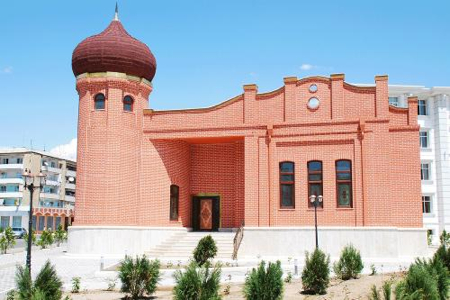 schooling for its plan structure and self composition show that it is the product of the 17-18 centuries rich construction traditions. In the 17-18 centuries together with previous years traditions in Azerbaijan architecture, new construction inclinations also displayed their promotion. The change in the construction types are mainly connected with the religious demands supply in a large scale form. Though the building of Zaviya-madrasa at first glance seems a squareshaped form but it possesses a very complicated architectural structure. The building was based on a rostrum at 1 m high from the ground. Total capacity is 212 m2, thickness of walls changes between 0,9-1,5 m. Main thickness is 90 cm. It was built of burnt bricks and lime solution bricks are of two sizes. Yellow colour bricks of 20x20x5 cm were used in the main construction of the building. In the second half of the 19 century in the process of a capital repair of the mosque, red colour bricks of 26x13x5 cm were used much more. In the process of rebuilding these bricks were mainly used in the east and north walls, in their partitions in the anthamblement attached on the minarate head part and building itself, in the pit and also in the facade of a building. The mosque completely differs from the other mosques in Nakhchivan either for its plan structure or for the forms of different parts. Very likely, during repair works held at the end years of the 19 century the architectural structure was rather changed because of adding new constructions and forms, instead of joined span and spherical domes used in the constructions it was substituted with complicated lined spans and straight roof cover characteristic for the 19 century. Just for this to precise the date of its constructions is very difficult. The present interior structure of the buildings consists of a big salon for praying, a vestibule joined to it, three subsidiary two storeyed rooms and a minarat with winding stairs. As spherical domes of salon and other constructions were destroyed, it was substituted with the straight lined cover at the end of the 19 century. From three sides there is an entrance door to the building; one door from the west and north direction, from the yard in the east direction three doors. The key entrance is from the west. The straight lined portal in the west direction was arranged as a porch form. Marble stairs lead to the porch. From the door in the entrance portal enters the triangleformed vestibule. The capacity of the vestibule is 19,8 m2. There is a room like worship salon in the right side from the vestibule with the sizes 5,5 m at height, capacity 88 m2. There is an entrance to the salon from the east direction too. Three latticed windows of 0,9x3,2 m size were placed in each east and west wall of the salon. The praying salon altar was placed in the s wall of 1,7x5,15x5,5 m sizes in a separate section form. The joined span recess of the altar and other decorations were plastered as a result of multi repair and became a plain surface. There are two doors on the left of the vestibule. One of them opens to the winding stairs of the minarate but another one opens to the subsidiary rooms. Access to the rooms on the first floor considered for women is by means of wooden stairs. Between a praying room and a main salon there is a window. The main facade of the building consists of a porched portal arranged in the center, three longish latticed windows and a minarate not so high. The antamblement not matching with the facade and was attached to the joined span motived parapet building surrounding the head part of construction, later on. Projections of four squareshaped columns in the antamblement and roundshaped spaces placed in the center are completely seen as a strange element in the facade of the building. The building was used as a club, pioneers house religion office and for other purposes in the 20 century. The women Assembly of Nakh. AR. was located in this building until 2007. It was capitally constructed and restored in 2008.
schooling for its plan structure and self composition show that it is the product of the 17-18 centuries rich construction traditions. In the 17-18 centuries together with previous years traditions in Azerbaijan architecture, new construction inclinations also displayed their promotion. The change in the construction types are mainly connected with the religious demands supply in a large scale form. Though the building of Zaviya-madrasa at first glance seems a squareshaped form but it possesses a very complicated architectural structure. The building was based on a rostrum at 1 m high from the ground. Total capacity is 212 m2, thickness of walls changes between 0,9-1,5 m. Main thickness is 90 cm. It was built of burnt bricks and lime solution bricks are of two sizes. Yellow colour bricks of 20x20x5 cm were used in the main construction of the building. In the second half of the 19 century in the process of a capital repair of the mosque, red colour bricks of 26x13x5 cm were used much more. In the process of rebuilding these bricks were mainly used in the east and north walls, in their partitions in the anthamblement attached on the minarate head part and building itself, in the pit and also in the facade of a building. The mosque completely differs from the other mosques in Nakhchivan either for its plan structure or for the forms of different parts. Very likely, during repair works held at the end years of the 19 century the architectural structure was rather changed because of adding new constructions and forms, instead of joined span and spherical domes used in the constructions it was substituted with complicated lined spans and straight roof cover characteristic for the 19 century. Just for this to precise the date of its constructions is very difficult. The present interior structure of the buildings consists of a big salon for praying, a vestibule joined to it, three subsidiary two storeyed rooms and a minarat with winding stairs. As spherical domes of salon and other constructions were destroyed, it was substituted with the straight lined cover at the end of the 19 century. From three sides there is an entrance door to the building; one door from the west and north direction, from the yard in the east direction three doors. The key entrance is from the west. The straight lined portal in the west direction was arranged as a porch form. Marble stairs lead to the porch. From the door in the entrance portal enters the triangleformed vestibule. The capacity of the vestibule is 19,8 m2. There is a room like worship salon in the right side from the vestibule with the sizes 5,5 m at height, capacity 88 m2. There is an entrance to the salon from the east direction too. Three latticed windows of 0,9x3,2 m size were placed in each east and west wall of the salon. The praying salon altar was placed in the s wall of 1,7x5,15x5,5 m sizes in a separate section form. The joined span recess of the altar and other decorations were plastered as a result of multi repair and became a plain surface. There are two doors on the left of the vestibule. One of them opens to the winding stairs of the minarate but another one opens to the subsidiary rooms. Access to the rooms on the first floor considered for women is by means of wooden stairs. Between a praying room and a main salon there is a window. The main facade of the building consists of a porched portal arranged in the center, three longish latticed windows and a minarate not so high. The antamblement not matching with the facade and was attached to the joined span motived parapet building surrounding the head part of construction, later on. Projections of four squareshaped columns in the antamblement and roundshaped spaces placed in the center are completely seen as a strange element in the facade of the building. The building was used as a club, pioneers house religion office and for other purposes in the 20 century. The women Assembly of Nakh. AR. was located in this building until 2007. It was capitally constructed and restored in 2008.
